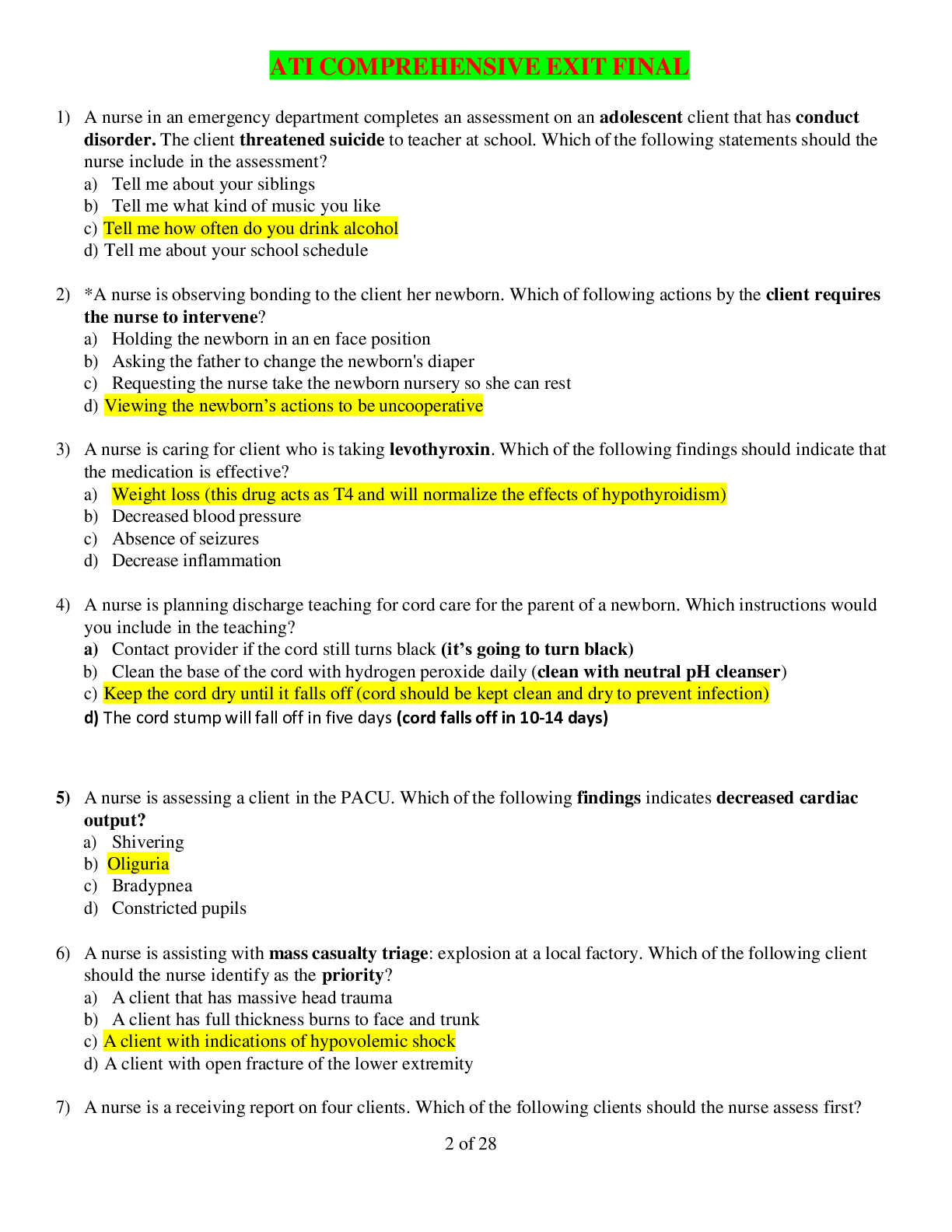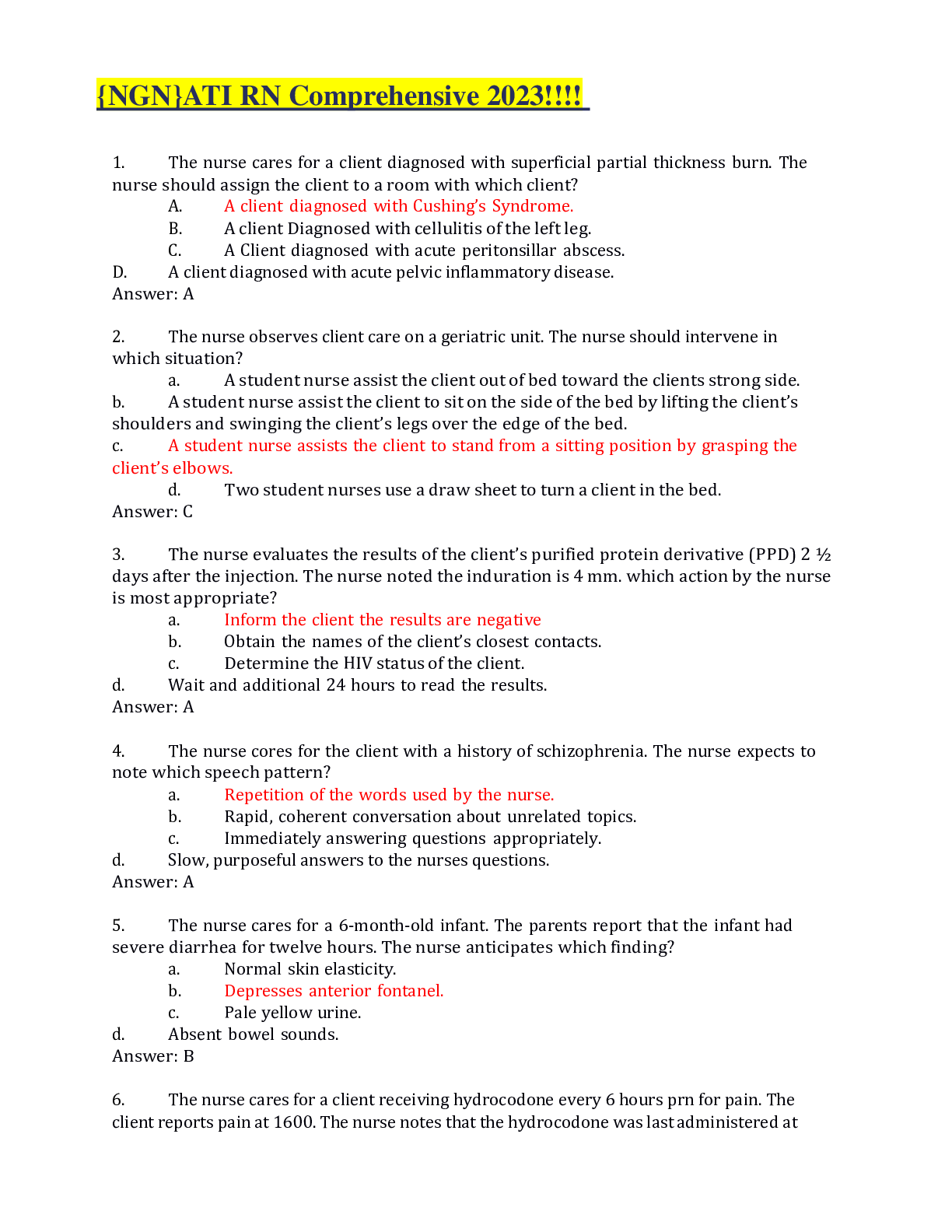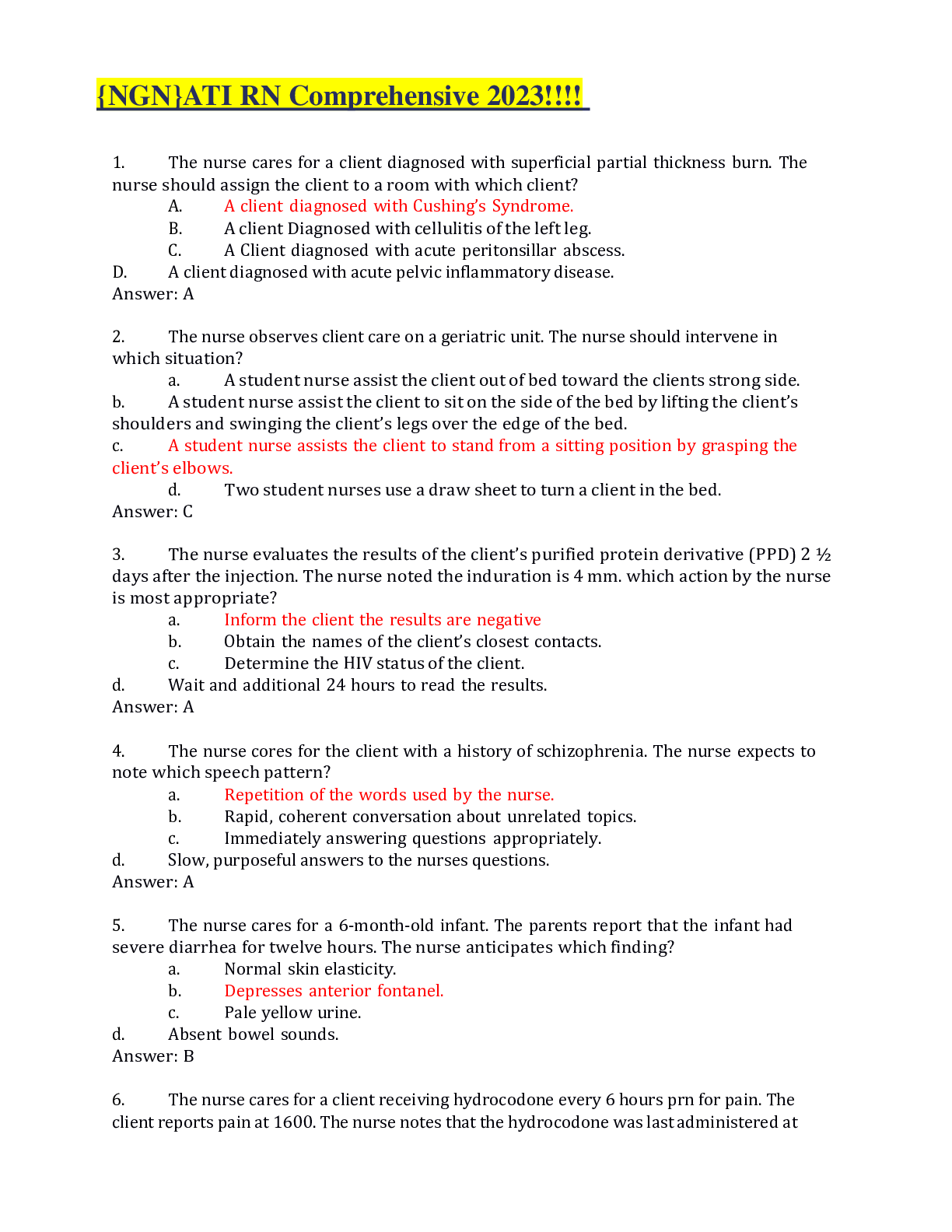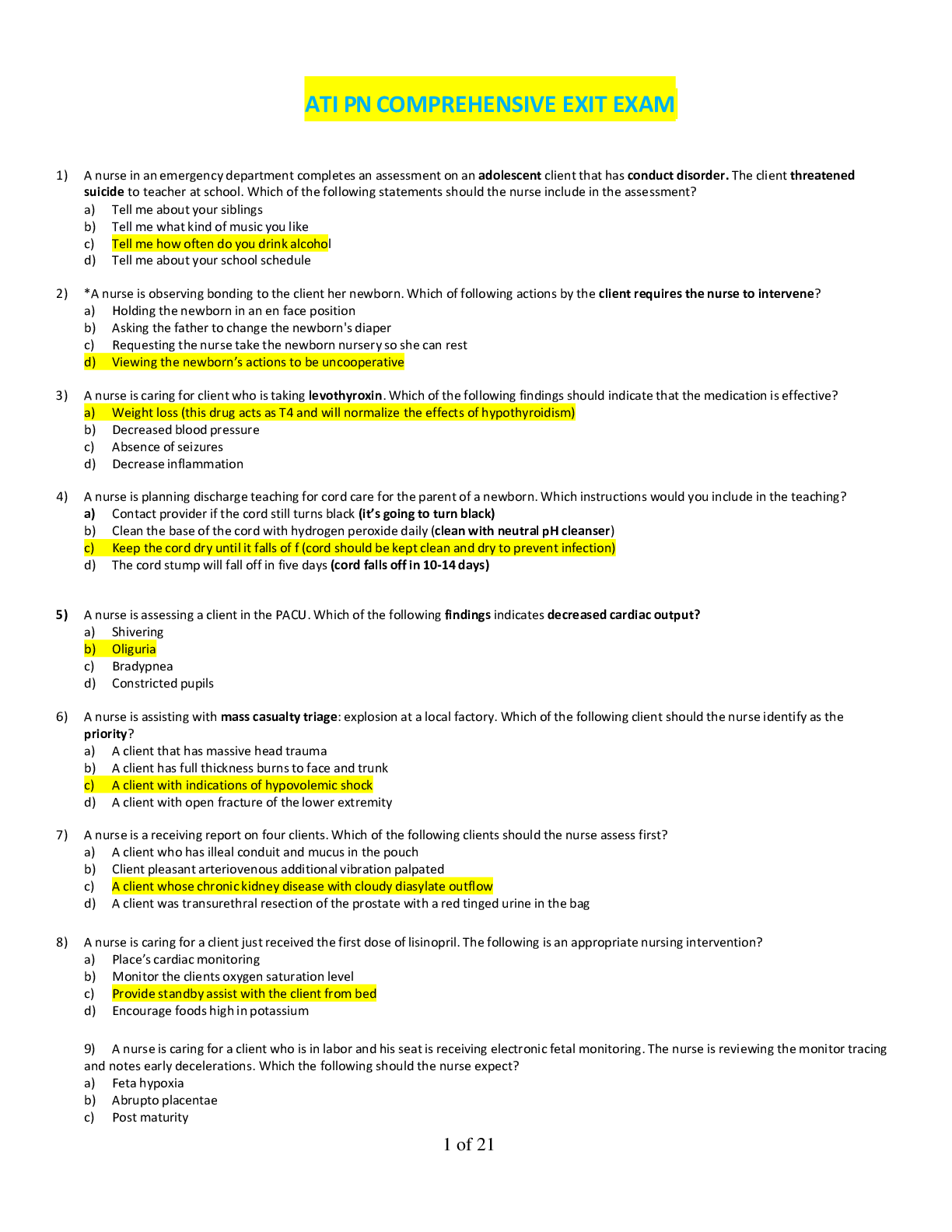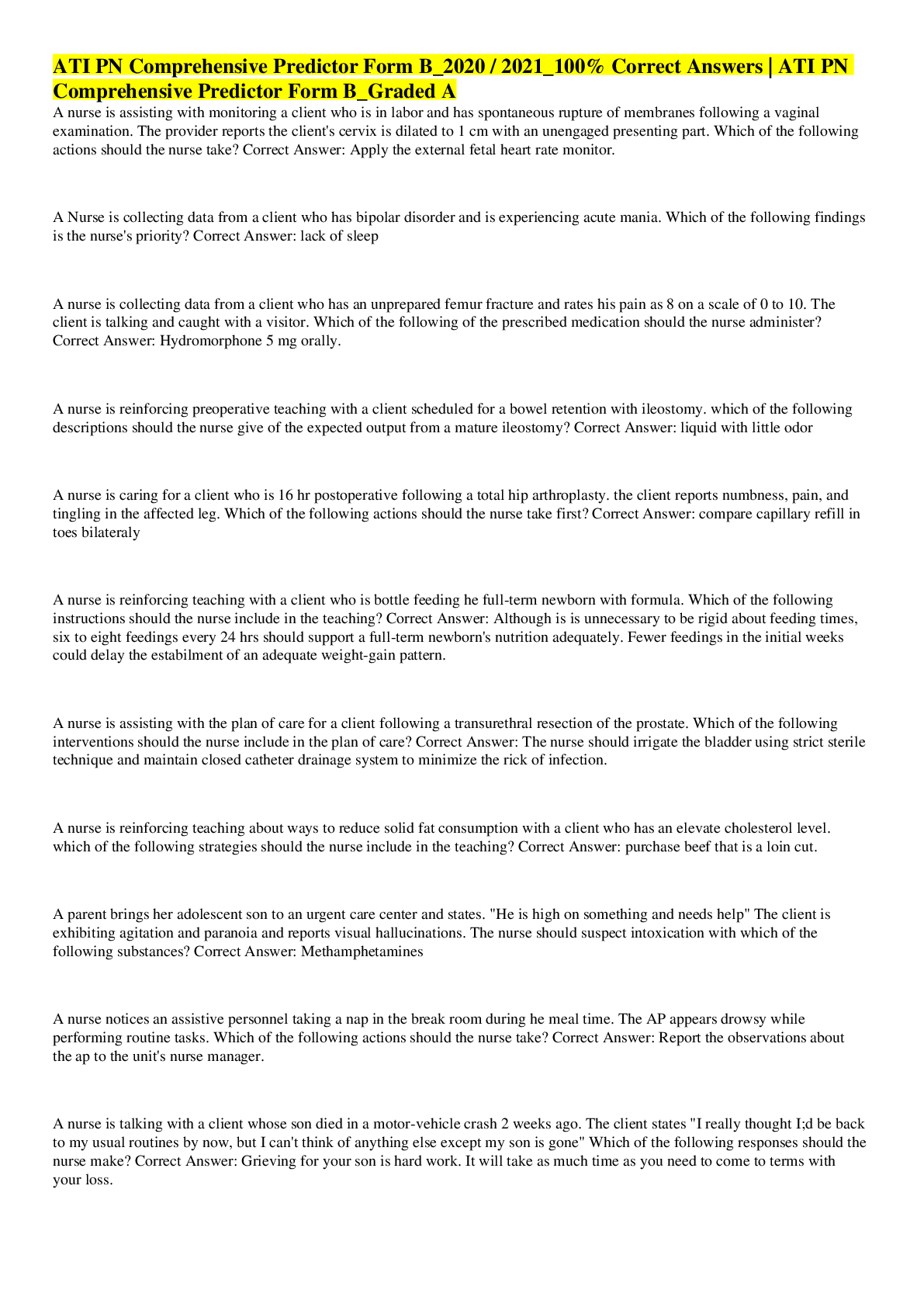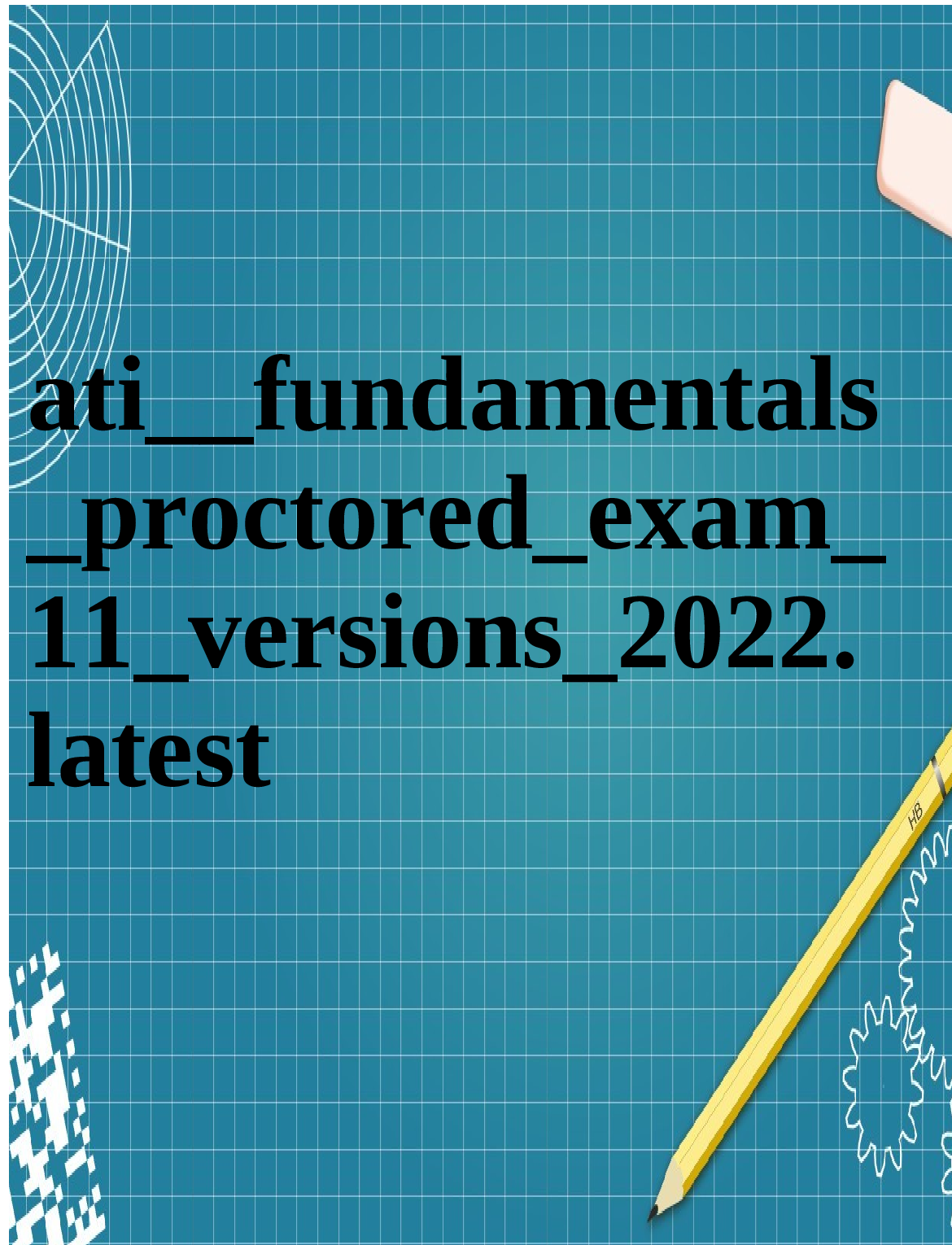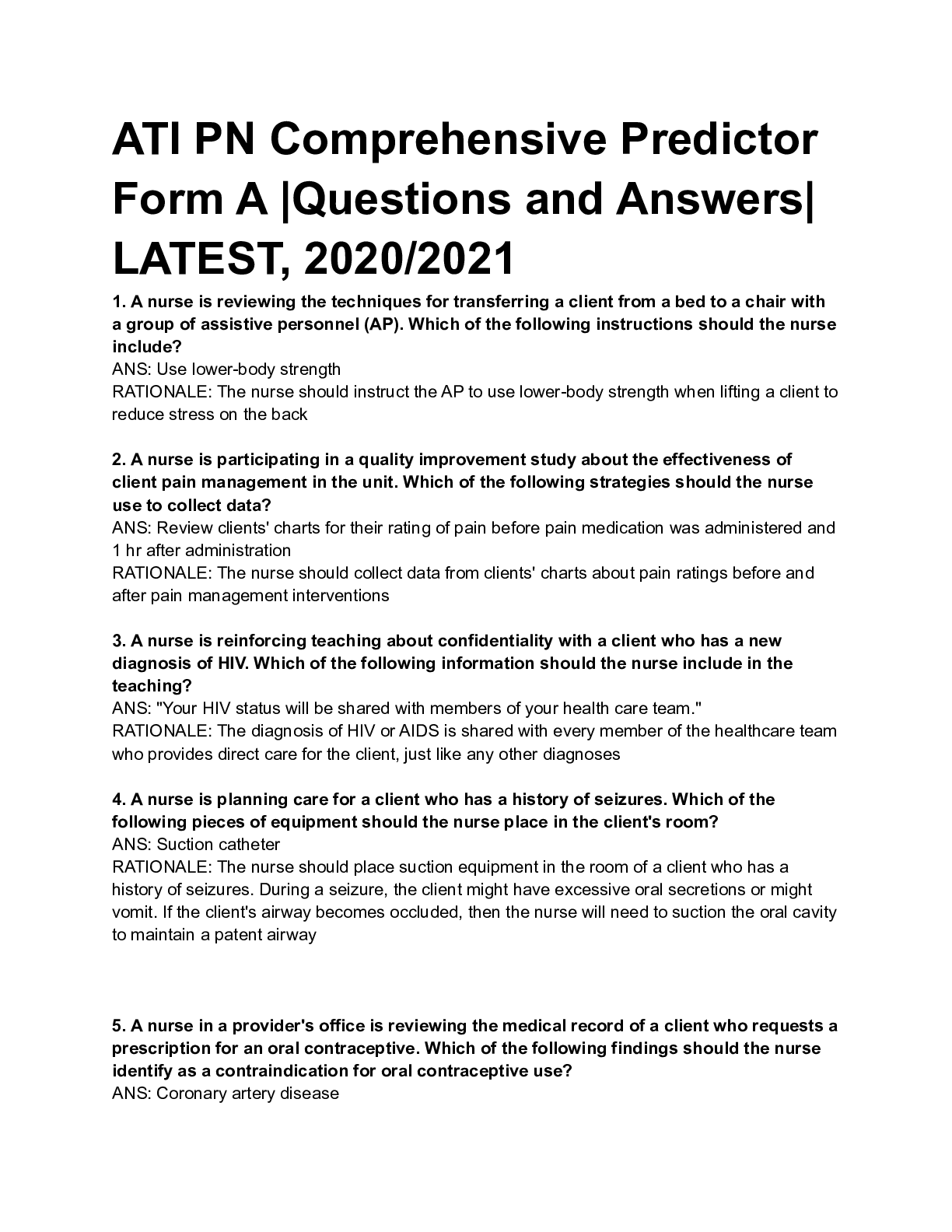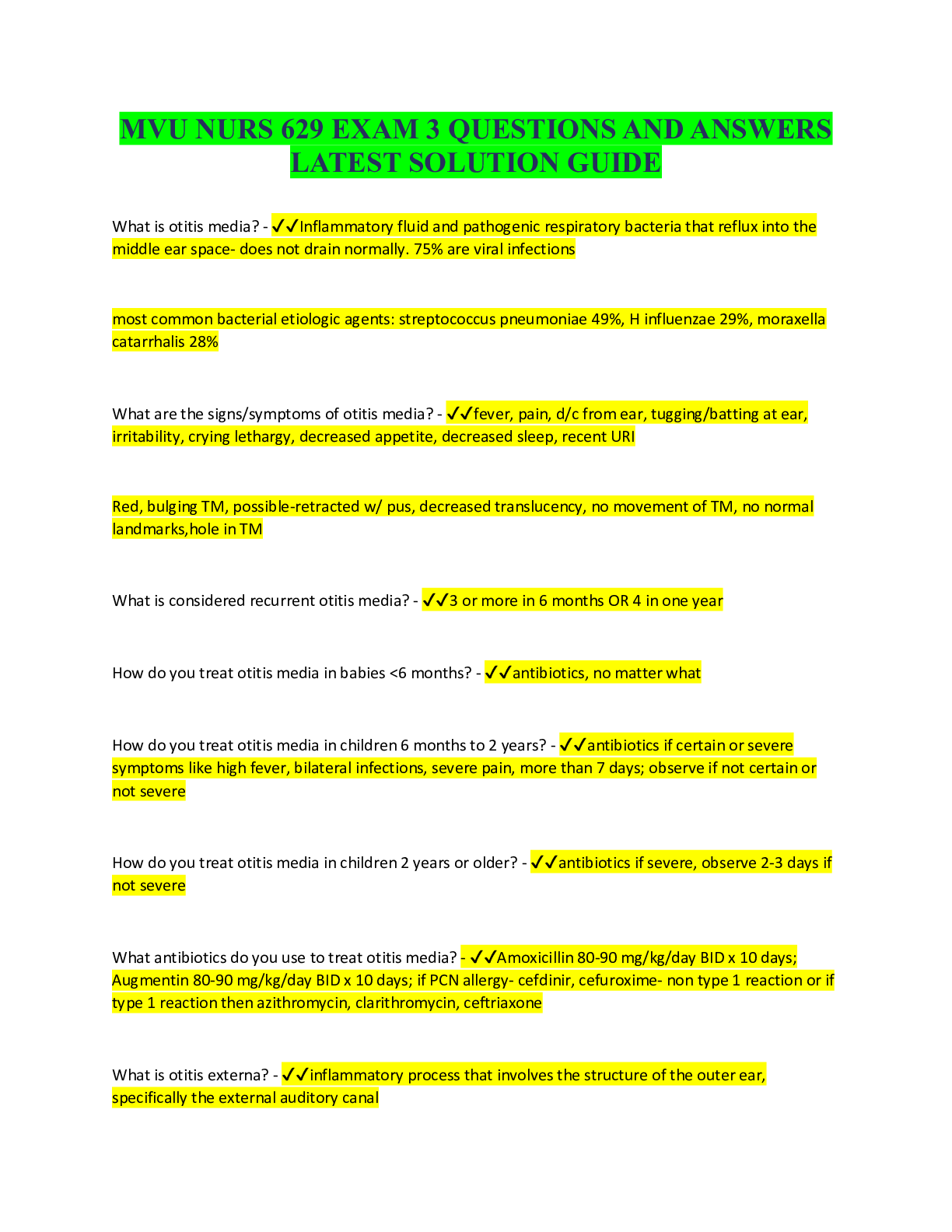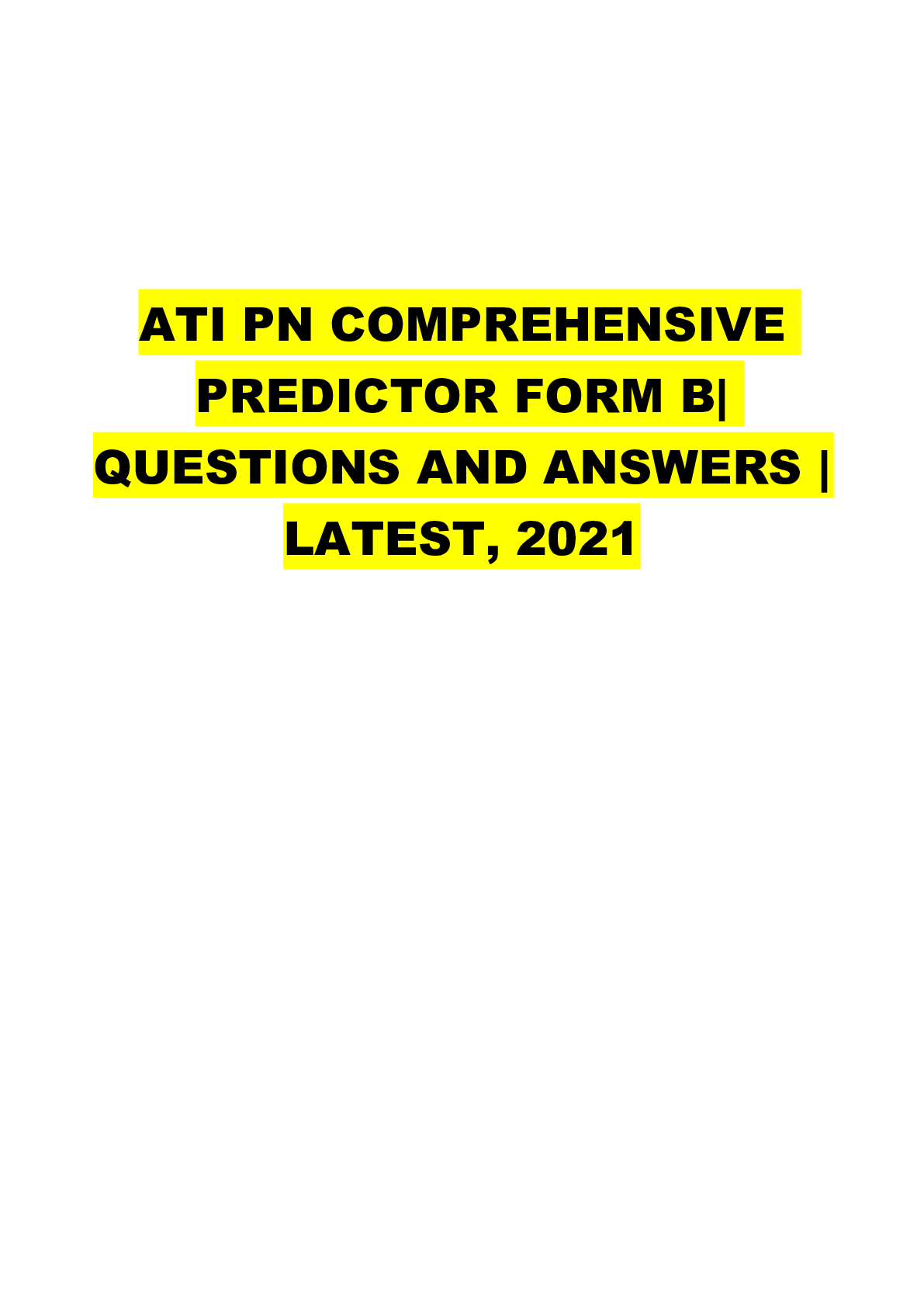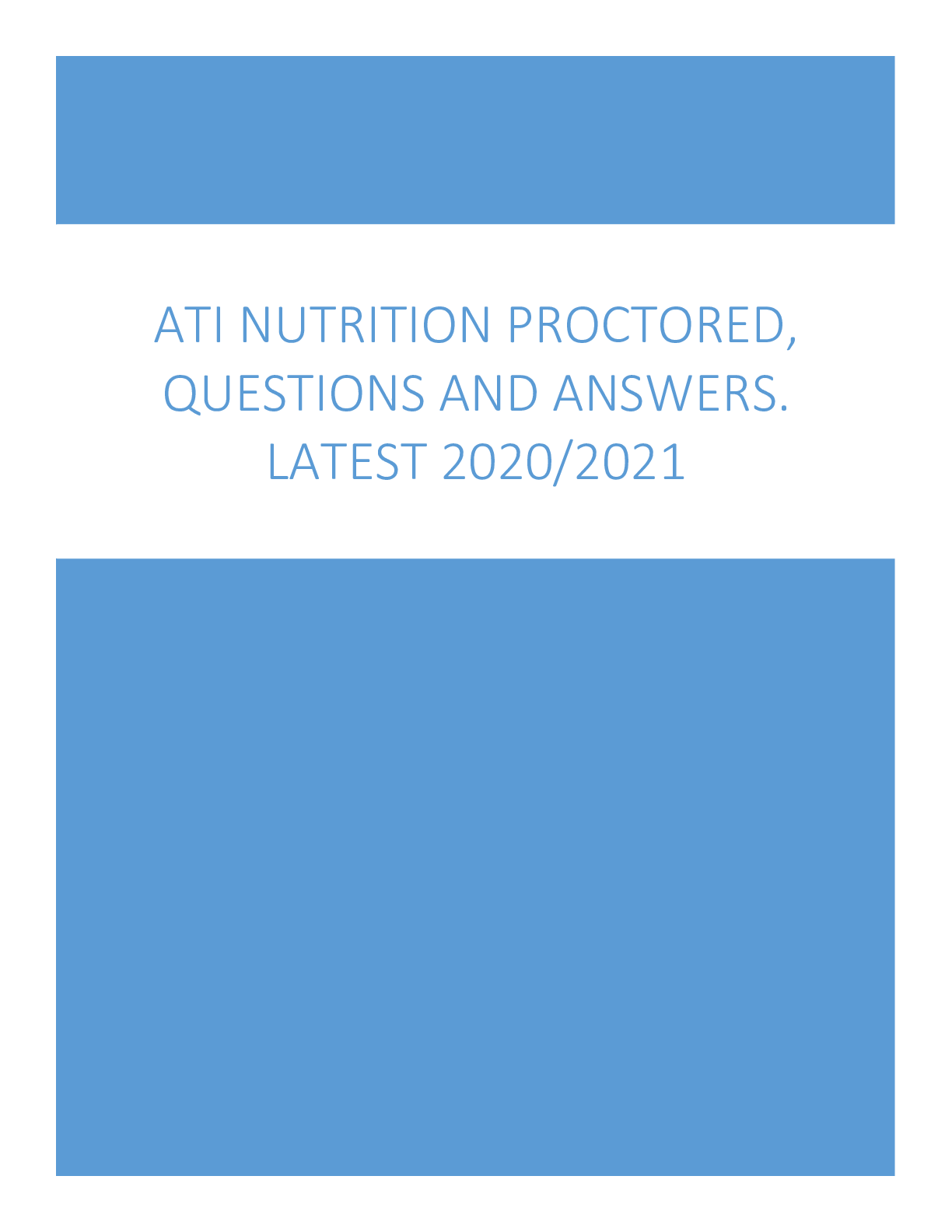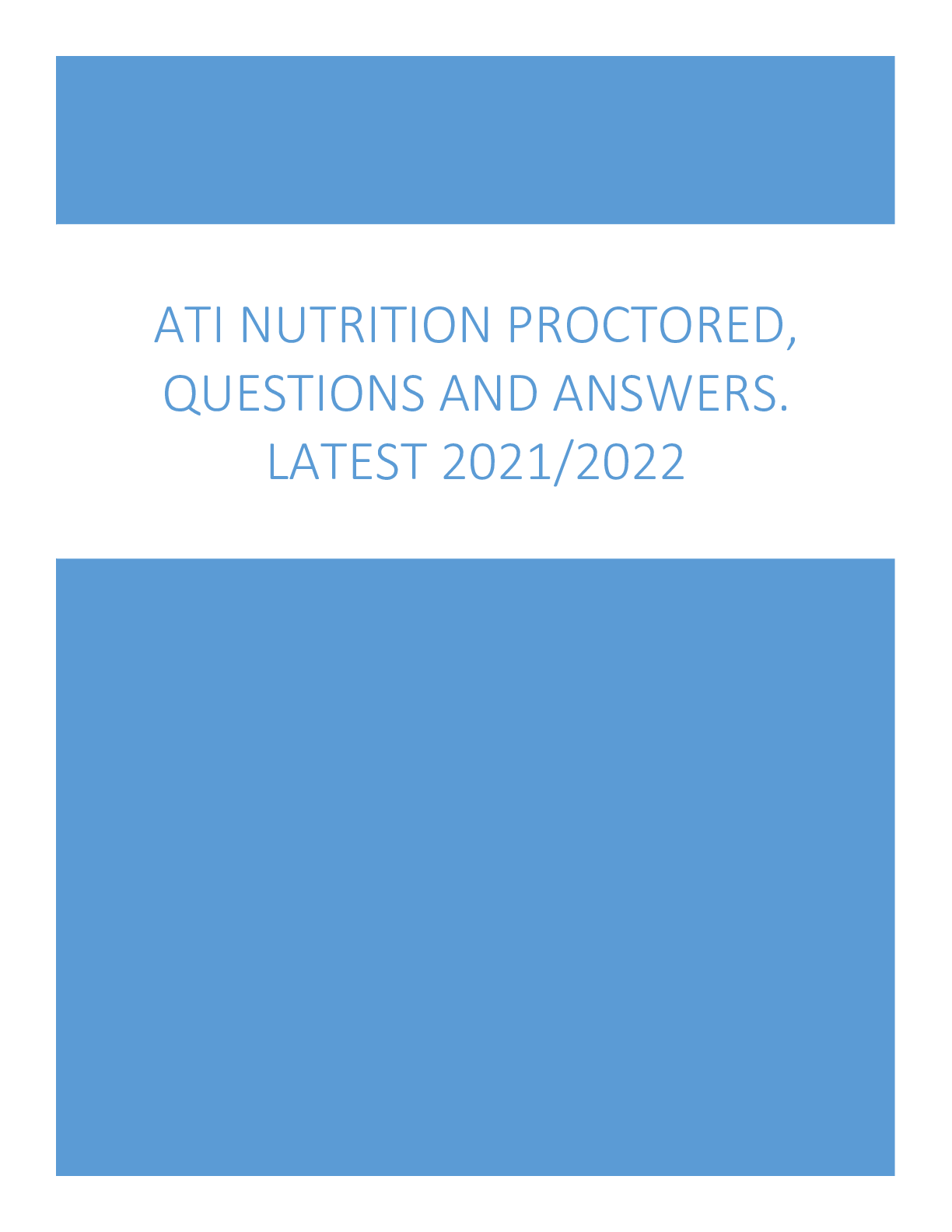*NURSING > ATI > ATI Teas 7 question bank With 303 Questions and Answers Latest Updated 2022/2023,100% CORRECT (All)
ATI Teas 7 question bank With 303 Questions and Answers Latest Updated 2022/2023,100% CORRECT
Document Content and Description Below
ATI Teas 7 question bank With 303 Questions and Answers Latest Updated 2022/2023 1. How are carbohydrates used by the body? Choose ALL answers that apply. • structure • Communication • stora... ge • Recognition 2. What type of immunity does a vaccine provide? Choose only ONE best answer. • naturally acquired passive immunity • Artificially acquired passive immunity • Naturally acquired active immunity • Artificially acquired active immunity 3. Which organs and/or glands are superior to the liver? Choose ALL answers that apply. • Lungs • Parathyroid gland • Kidneys • Thymus 4. Which cavity contains all of the frontal cavities? Choose only ONE best answer. • Dorsal • Thoracic • Abdominopelvic • Ventral 5. Which of the following carry oxygenated blood? Choose ALL answers that apply. • Pulmonary artery • Pulmonary vein • Aorta • Superior vena cava 6. Which of the following are disaccharides? Choose ALL answers that apply. • Sucrose • Glucose • Cellulose • Lactose 7. Which body system is responsible for the transport of dissolved oxygen from the lungs to the spleen? • Immune • Endocrine • Respiratory • Cardiovascular 8. Which condition can lead to blood clots and stroke? • Aneurysm • Arrhythmia • Asthma • Hypertension 9. A botanist wants to determine if environmental temperature affects root growth. In her experiment, she creates 4 rooms at temperatures that vary by 5 degrees F. Each room gets 20 seedlings of the same species, which she grows on agar plates for 60 days. Once a day, she measures the length of each seedling's root. At the end of 60 days, she compares the length of the roots with the room temperature. She finds the room with the lowest temperature produced the longest roots. What is the independent variable in this study? • Temperature • Seedlings • Light • Root length 10. Which of the following can act as enzymes in the body? • Globular proteins • Lipase • Amylase • Glucagon 11. Which of the following is the carbohydrate monomer? • Disaccharide • Lactose • Monosaccharide • Thymine 12. Which of the following are true about water? • Water has polar covalent bonds. • Water has a neutral pH of 7. • Water has a low specific heat capacity. • Water as a solid is less dense than water as a liquid. 13. Hydrophobic proteins often provide which function in the body? • Digestive enzymes • Provide structure • Carry oxygen molecules • Store energy 14. Which of the following have a smaller genetic scale than a chromosome? • Genome • Gene • DNA • All of the above 15. What best measures the volume of a solid? • Triple beam balance • Measuring wheel and mathematical formula • Graduated cylinder • Measuring wheel 16. What cavities are in the ventral cavity of the human body? • Thoracic Cavity • Abdominal Cavity • Cranial Cavity • Pelvic Cavity 17. Which is the largest part of the airway? • Alveoli • Bronchi • Bronchioles • Trachea 18. Which of the following is an effect of high blood pressure? • Smoking • Excessive dietary salt • Renal vessel damage • Older age 19. What is the monomer for nucleic acids? • Nucleotide • Amino acid • Phosphate group • Ribosome 20. Consider the graph which represents a botanist's data of root growth. What is the independent variable? • Temperature • Root tissue • Light exposure • Root length 21. What type of tissue protects the respiratory system's trachea? • Bone • Cartilage • Collagen • Keratin 22. Which of the following are examples of covalent bonds? • H₂O • NaCl • C₆H₁₂O₆ • MgO • 23. Which of the following is an example of Mendelian inheritance? • Incomplete Dominance • Polygenic Alleles • Combination Inheritance • Recessive Inheritance 24. Which of the following are globular proteins? • Antibody • Enzyme • Hemoglobin • Keratin 25. What type of bond connects amino acids? • Covalent • Peptide • Ionic • Hydrogen 26. What is the name for a microorganism that lives on or in the human body and normally causes no disease or harm? • Bacteria • Commensal Microorganism • Microorganism • Host 27. of the following infectious diseases can be caused by a viral infection? • COVID-19 • Varicella • Mumps • Measles 28. You are a nursing student and are triaging a patient. Which of the following is an example of quantitative data you can gather? • The patients say he feels pain. • The patient says he has stabbing pain in his right lower abdomen. • The patient's temperature is 101.7 degrees F. • The patient reports that he had a fever yesterday 29. Which of the following are examples of steroids in the human body? • Cholesterol • Testosterone • Cortisol • Estradiol 30. What of the following factors influence the rate of a chemical reaction? • Temperature • Pressure • Concentration of reactants and substrate • Any catalysts 31. Which of the following infectious diseases can be caused by bacteria? • Tuberculosis • Cholera • Varicella • Influenza 32. During which of the following stages does crossing over occur? • Mitosis Prophase • Meiosis Prophase I • Meiosis Prophase II • Interphase 33. Which of the following is correct based on anatomical terms? • The shoulder joint is proximal to the neck. • The elbow joint is superior to the shoulder. • The thoracic vertebrae are superior to the cervical vertebrae. • The thumb is on the lateral aspect of the hand. 34. Which of the following is a genetic condition that affects the respiratory system? • Asthma • Cystic fibrosis • Mycosis • Surfactant Deficiency 35. A particular atom is uncharged, and it has an electron configuration of 1s2 2s2 2p⁶ 3s2 and a mass number of 14. How many protons does it have? • 14 • 6 • 8 • 12 36. Which of the following describes the term allele? • A base-pair substitution in DNA • An inheritable variation of a gene • A grouping of various genes • Variations of complementary base pairs 37. Which of the following is part of the cardiovascular system? • Blood vessels • Brain • Kidneys • Lungs 38. Which of the following are possible effects of obesity? • Reduced exercise • Joint and body pain • Hypertension • Diabetes 39. Which of the following factors does not strengthen a scientific argument? • Lack of bias. • Extensive use of qualitative research and data. • Able to be reproduced and repeated by others. • Withstands the test of time 40. Which of the following are functions of the kidneys? • Make urine and maintain water homeostasis • Help maintain blood pressure • Synthesize Vitamin D • Filter blood of salt, nutrients, water, and waste 41. Which of the following correctly orders the layers of the epidermis from most superficial to deepest? • S. spinosa, S. Basale, S. corneum, S. granulosum, S. lucidum • S. corneum, S. lucidum, S. granulosum, S. spinosum, S. Basale • S. corneum, S. spinosum, S. Basale, S. granulosum, S. lucidum • S. Basale, S. spinosum, S. granulosum, S. lucidum, S. corneum 42. What of the following statements is true about an allergic reaction? • An allergic reaction, like hives or wheezing breath, is the result of overactive body systems like the integumentary system and respiratory system. • An allergic reaction is a function of overactive B-cells in the body, which release various immunoglobulins. • An allergic reaction is a function of overactive mast cells in the body, which are stimulated by Immunoglobulin E. • An allergic reaction involves proteins like histamine, keratin and collagen. 43. Alkali metals are in which group of the periodic table? • Group 1 • Group 2 • Group 7 • Group 8 44. Which term refers to a molecule of DNA and structural protein? • Lysosome • Centrosome • Chromosome • Genome 45. If Silicon (Si) has an atomic mass of 28.1 AMU (atomic mass units), which of the following is the most likely number of neutrons an atom of Silicon would have? • 28.1 • 14 • 28 • 14.2 46. Which neuromuscular system controls voluntary movement? • Autonomic • Somatic • Sympathetic • Parasympathetic 47. Which of the following is another name for a sweat gland? • Ceruminous • Sebaceous • Sudoriferous • Integumeous 48. Which of the following is another name for the voice box? • Alveoli • Larynx • Trachea • Pharynx 49. Which term refers to the relaxation of heart muscle? • Diastole • Systole • Asystole • Cardiastole 50. What is located in the skin's dermis? • Blood vessels • Nerve endings • Collagen • Melanocytes 51. Fat is primarily digested in the , and protein is primarily digested in the . • mouth; stomach • stomach; small intestine • small intestine; small intestine • small intestine; stomach 52. Which of the following produces the first heart sound ("lub")? • The closing of the aortic and pulmonary valves • The closing of the tricuspid and mitral valves • The opening of the aortic and pulmonary valves • The opening of the tricuspid and mitral valves 53. Following the scientific method, which steps would be done before gathering qualitative data? • Communicate with a scientific journal • Define the problem • Develop a hypothesis • Categorize data for statistical analysis 54. Which hormone is released by the pituitary? • Estrogen • Luteinizing Hormone • Progesterone • Testosterone 55. Which of the following does not describe a general trait of macromolecules? • They can be single chains. • They can be branched. • They all contain carbon, hydrogen, and phosphorus. • They all are used by the body. 56. The kidneys reabsorb water, salts, and nutrients and return them to the body through which structure? • Renal artery • Renal vein • Nephron • Glomerulus 57. Which of the following best describes a group of cells working together? • Organelle • Tissue • Organ • Organ system 58. If a patient had a heart attack and tissue in the left ventricle lost blood flow, what would you most expect to happen? • Blood would not flow from the lungs. • Blood would back up in the legs. • Blood would not be pumped to the body. • Blood would not be oxygenated. 59. Which of the following immune cells are part of the innate immune response?. • B-cells • Cytotoxic T-cells • Natural Killer Cells • Antigen-Presenting Cells 60. Which hormone is released by the ovaries to mature an egg? • Estrogen • Luteinizing Hormone • Progesterone • Testosterone 61. Which of the following are examples of positive correlation? • As rainfall increases, plant stem length slows. • As rainfall increases, roots show longer length. • When plotting a comparison of rainfall to plant length, the line trends to the lower right. • When plotting a comparison of rainfall to plant length, the line trends to the upper right. 62. Iron is a transition metal, which means it often forms a cation with a charge of what? • 2- or 3- • 1- • 2+ or 3+ • 1+ 63. Which of the following is in DNA? • Uracil • Deoxyribose • Guanine • Phosphate group 64. How does renin regulate blood pressure? • It signals the collecting ducts to expel more urine. • It affects the amount of water and salt stored or released by the body. • It signals the heart to reduce its systole contraction. • It relaxes blood vessels. 65. Which of the following has an acidic pH? • Lemon juice • Blood • Urine • Salt water 66. Which of the following are properties of a liquid? • High atomic attraction • Fixed volume • Low pressure • Takes shape of container 67. Which cavity is primarily lined by the peritoneum? • Abdominal • Dorsal • Ventral • Thoracic 68. A veterinarian student designs a study to examine the nutritional qualities of dog food. She believes that a grain-free diet can affect dog health. She selects 3 of the top-selling dog food brands for her study. From a local humane society, she selects several chihuahua puppies under the age of 1 year. She will track these puppies for the next year and access their health, include weight, complete blood count, and paw size. Three puppies will be fed nothing but brand #1 dog food, 10 puppies will only be fed Brand #2, and 10 puppies will only be fed Brand #3. How the researcher best improves this experiment? • The experiment should include 7 more dogs for the Brand #1 group. • The daily serving size of kibble should be controlled. • The experiment needs a clearly defined control of puppies. • All of the above are ways to improve the experiment. 69. Which of the following is changed during a scientific investigation? • The dependent variable. • The control. • The hypothesis. • The independent variable. 70. Which of the following are true about the dependent variable? • A factor that remains constant during the experiment • A factor with data typically plotted on the x-axis • A factor that is measured during an experiment • A factor with data typically plotted on the y-axis 71. Which two types of elements will most likely form an ionic bond? • Two elements that are in the same period. • Two elements that are non-metals and have p orbitals. • One element that is a transition metal with d orbitals and one element that is a metal with s orbitals. • One element that is a metal with s orbitals and one element that is a non- metal with p orbitals. 72. Which of the following is in the pelvic cavity? • The kidneys • The colon • The bladder • The rectum 73. Water is considered a universal solvent due to its . • Cohesion • Adhesion • Molarity • Dilution 74. What best measures the volume of a cube? • Triple beam balance • Measuring wheel and mathematical formula • Graduated cylinder • Measuring wheel 75. How many pairs of chromosomes are in a human cell? • 46 • 23 • 64 • 32 76. Which of the following are true about Noble gasses? • They are non-reactive. • They are highly reactive. • They have 8 valence electrons. • They have 7 valence electrons. 77. Which of the following macromolecules will always contain nitrogen? • Fatty acid • Protein • Lipid • Carbohydrate 78. DNA has both a "sense" and "antisense" strand. What is true about the antisense strand? • It runs 5' to 3'. • It runs 3' to 5'. • It is used in replication. • It is the direction DNA is stored 79. Which of the following best defines the anatomical term medial? • Being face down • On the front of the body or limb • Near to the midline of the body • Above or on top of lungs 80. Which of the following is not a biological macromolecule? • Glycoproteins • DNA • Phospholipid • Glucose 81. Which of the following is a property of water? • Water has a neutral pH. • Water has a low specific heat capacity. • Water has polar covalent bonds. • Water can dissolve almost any solid, liquid, or gas. 82. Which of the following is the strongest scientific argument? • Scientific Hypothesis • Scientific Law • Scientific Study Conclusion • Scientific Theory 83. In which type of cell would you expect to find a high concentration of lysosomes? • Cardiac cells • Glandular cells • Immune cells • Muscle cells 84. What are the general functions of proteins in the body? • Increase reaction rates • Provide immunity • Provide transport • Provide structure 85. Which means of calculating concentration depends on pressure? • ppm • ppb • molarity • molarity, ppb, and ppm 86. A veterinarian student designs a study to examine the nutritional qualities of dog food. She believes that a grain-free diet can affect dog health. She selects 3 of the top-selling dog food brands for her study. From a local humane society, she selects several chihuahua puppies under the age of 1 year. She will track these puppies for the next year and access their health, include weight, complete blood count, and paw size. Three puppies will be fed nothing but Brand #1 dog food, 10 puppies will only be fed Brand #2, and 10 puppies will only be fed Brand #3. What is the independent variable in this experiment? Time Dog weight Dog species Dog food type 87. A scientist wants to conduct qualitative research. Which method should she use? • Collecting patient narratives • Tracking the dosage of a drug and its blood levels in the patient • Observing a patient's physical changes • Writing journal notes about the research experience 88. Which of the following are functions of the kidney? • Release cortisol • Maintain water homeostasis • Filter blood of salt, nutrients, water, and waste • Store urine (waste from digestive system from protein breakdown) 89. Which of the following is a role of follicle-stimulating hormone? • Triggers the production of testosterone • Stimulates development of ova • Stimulates development of sperm • Triggers ovulation 90. What type of bond connects amino acids? • Covalent • Peptide • Ionic • Hydrogen 91. Which organ makes insulin and glucagon? • Salivary Glands • Liver • Gallbladder • Pancreas 92. If an atom has 32 neutrons, 17 protons and 19 electrons, what is its charge? • Positive • Negative • Neutral • Cannot be determined. 93. How does AIDS cause a failure in the immune system? • Helper T-Cells can’t activate Cytotoxic T-Cells or B-Cells. • IgE makes mast cells release too much histamine. • IgE makes mast cells release too little histamine. • Helper T-Cells trick the body into attacking itself. 94. A scientist wants to conduct quantitative research. Which method should she use? • Collecting patient narratives. • Tracking the dosage of a drug and its blood levels in the patient. • Observing a patient's physical changes. • Writing journal notes about the research experience. 95. Which of the following is NOT true about DNA? • DNA contains the nucleotides A, T, C, G and is read 5' to 3'. • DNA contains genetic information and is tightly coiled with protein to form chromosomes. • DNA contains the nucleotides A, T, C, G and is read 3' to 5'. • DNA is a double-stranded molecule that is connected by hydrogen bonds. 96. Which region of the small intestine is the primary site of absorption? • Duodenum • Jejunum • Ileum • Cecum 97. What some examples of proteins in the human body? • Keratin • Hemoglobin • Enzyme • Chitin 98. What step of the scientific method must come before generating a hypothesis? • Collecting and organizing data. • Communicating the results in a scientific journal. • Conducting an experiment. • Researching previous studies for background. 99. An FBI agent has spent her career studying individual serial killers. From this data, she creates a theory about the traits of these killers. What type of reasoning has she used? • Deductive Reasoning • Conductive Reasoning • Quantitative Reasoning • Inductive Reasoning 100. Which of the following is not true about the relationship between the gastrointestinal system and the endocrine system? . • Hormones signal to your body if you are hungry or full. • Hormones regulate the amount of glucose in your blood. • Hormones stimulate digestive enzymes and peristalsis when you've eaten and need to digest all the food. • All of the above are true. 101. Where is keratin? • It is a protein-digesting enzyme released by the stomach. • It is. released in the neuromuscular junction. • It is a protein found in the hypodermis. • It is a protein found in hair. 102. Sulfur has an atomic number of 16 and an atomic mass of approximately 32. How many neutrons and electrons could a negative ion of Sulfur have? • 16 neutrons, 16 electrons • 16 neutrons, 17 electrons • 17 neutrons, 16 electrons • 17 neutrons, 17 electrons 103. is the function of the Vas Deferens? • Makes fluid to increase sperm mobility • Site where the egg matures • Helps control urine flow • Connects each testis to the urethra 104. Dysentery is an infectious disease caused by what type of microbe? • Helminth • Bacteria • Protozoan • Fungus 105. Consider the graph which represents a botanist's data of root growth. What is the independent variable? Choose • Temperature • Root tissue • Light exposure • Root length 106. Which of the following best describes the relationship among density, volume, and mass? • As volume increases, density increases. • As volume decreases, density increases. • An object's mass does not affect its density. • As volume decreases, mass increases. 107. Which term refers to the mechanical act of breathing? • Diffusion • Perfusion • Respiration • Ventilation 108. What do lacteals absorb? • Carbohydrates • Lipids • Proteins • Nonpolar nutrients 109. Which of the following indicates the body's draining of clear fluid throughout the body in order to protect it from infection? • Pulmonary Loop • Systemic Loop • lymphatic System • Immune System 110. Which of the following is a pathology caused by a virus? • Asthma • Cystic Fibrosis • Epiglottitis • Influenza 111. A botanist wants to determine if environmental temperature affects root growth. In her experiment, she creates 4 rooms at temperatures that vary by 5 degrees F. Each room gets 20 seedlings of the same species, which she grows on agar plates for 60 days. Once a day, she measures the length of each seedling's root. At the end of 60 days, she compares the length of the roots with the room temperature. She finds the the room with the lowest temperature produced the longest roots. Which of the following is best identified as a hypothesis? • The environmental temperature can affect the growth of a plant's root. • Plants need light to grow. • A colder environment produces longer roots. • Plants need 60 days in order to grow their roots. 112. Which of the following is another name for a sweat gland? • Ceruminous • Sebaceous • Sudoriferous • Integumeous 113. Which of the following often contains a carboxyl group? • Carbohydrate • Glycolipids • Amino Acid • DNA 114. What might happen if blood sugar begins to drop in the human body? • The pancreas releases insulin. • The liver releases stored glucose. • The liver stores glucose as glycogen. • The pancreas releases glucagon 115. Which is a function of the liver? • Makes bile • Stores bile • Turns waste ammonia into urea • Filters and detoxifies products of digestion 116. Which of the following is an end product of cellular respiration? • Oxygen • ATP energy • Carbon dioxide • Water 117. Which of the following are true about human diploid cells? • Diploid cells contain two sets of homologous chromosomes from 1 parent. • Human diploid cells have 46 chromosomes. • Human diploid cells have 23 chromosomes. • Diploid cells contain two sets of homologous chromosomes from each parent. • Diploid cells are most cells in the human body. • Diploid cells are gametes. 118. Which of the following ratios are examples of Mendelian inheritance? • 2:1 • 3:1 • 9:3:3:1 • 3:3:9:3 119. The variable is measured as a possible effect and is plotted on the axis. • Independent, x • Independent, y • Dependent, x • Dependent, y 120. How many pairs of chromosomes are in a human cell? • 46 • 23 • 64 • 32 121. What type of bond is in a salt? • Ionic • Nonpolar covalent • Polar covalent • Peptide 122. Where does mRNA translation typically occur? • On the ribosome • In the nucleus • In the cytoplasm • On the smooth endoplasmic reticulum 123. Which term refers to the space where lymph flows through the body? • Artery • Lumen • Interstitial space • Vein 124. Amino acids are the structural basis of proteins. What makes amino acids? • Amine group • Carboxyl group • Glycerol • Sugar residue 125. Sweat contains waste and help regulates body temperature. Which of the following are found in sweat found in the skin's glands? • Vitamin D • Urea • Urine • Lactic acid 126. Which of the following infectious diseases can be caused by a protozoan? • Measles • Malaria • Mumps • Mononucleosis 127. Which of the following is made by Natural Killer Cells in order to create pores for rupture? • Interferon • Apoptosis • Perforin • Antibody 128. Which of the following does not describe a general trait of macromolecules? • They can be single chains. • They can be branched. • They all contain carbon, hydrogen, and phosphorus. • They all are used by the body 129. Which of the following is a bone in or near the hand? • Phalanges • Metatarsals • Metacarpals • Carpals 130. At which step in the scientific method might a scientist create a model? • Hypothesis • Data analysis • Experimentation • Conclusion 131. What is hydroxyapatite? • A mixture of minerals like calcium and phosphorus that strengthen the collagen matrix of bone. • The structural unit of a bone that runs the length of the bone. • The covering of bones at the point of articulation to prevent grinding. • The lightest portion of a long bone and concentrated at the ends. 132. What are the three main regions of the kidney? • Cortex • Renal arch • Renal pelvis • Medulla 133. Which number stays constant despite possible changes to the element? • Atomic number • Number of electrons • Atomic mass • Isotope form 134. Which structure of the endocrine system matures T-Cells? • Hypothalamus • Pineal • Thymus • Thyroid 135. KCl is an example of which type of bond? • Ionic bond • Covalent bond • Hydrogen bond • Polar Covalent 136. Which of the following is an example of a nonspecific defense? • Skin • Macrophages • T-cells • Fever 137. Consider the graph which represents a botanist's data of root growth. On which axis would she label with centimeters? • X-axis • Z-axis • Y-axis • The graph label 138. What do the proximal and distal convoluted loops do? • They collect urine before it travels to the bladder. • They filter water and nutrients and excrete them as waste. • They filter water and nutrients and absorb them back into the body. • They use blood pressure to filter platelets out of the blood. 139. Which of the following is an example of qualitative data? • Observation • Questionnaire ranking • Interviews • Longitudinal studies 140. Which type of bone cell is the most mature? • Osteocyte • Osteoclast • Osteoblast • Osteon 141. Which structure in the brain links electrical messages of the nervous system to the chemical messages of the endocrine system? • Hypothalamus • Medulla oblongata • Pineal • Pituitary 142. Which of the following is an intensive physical property of matter? • Melting point • Boiling point • Density • Luster 143. What is the difference between the apocrine glands and the eccrine glands of the skin's dermis layer? • Apocrine glands are a type of sebum gland; eccrine glands are a type of sudoriferous gland. • Apocrine glands are a type of sudoriferous gland; eccrine glands are a type of sebum gland. • Apocrine gland are sudoriferous gland that open into the dermis; eccrine glands are a type of sudoriferous gland that open into the epidermis. • Apocrine gland are sudoriferous gland that open into a hair follicle; eccrine glands are a type of sudoriferous gland that open into the epidermis. 144. What would the charge of an ion of Calcium be? • 1+ • 2+ • 1- • 2- 146. What is the functional unit of a muscle? • Actin • Myosin • Myofibril • Sarcomere unit 147. Which of the following affect the effectiveness of an enzyme? • Temperature • pH • Substrate • Inhibitor 148. Which of the following are the smallest units in muscle tissue? • Actin and myosin • Actin and sarcomere units • Myosin and sarcomere units • Actin and myofibril 149. Which of the following is not in the nucleic acid of RNA? • Adenine • Thymine • Guanine • Cytosine 150. Which compound is formed when the negative ions from an acid combine with the positive ions from a base? • Ester • Alcohol • Carboxyl group • Salt 151. Which of the following is an axial bone? • Sternum • Carpals • Calcaneus • Humerus 152. What happens to air as it moves through the trachea and bronchi? • The air only becomes warmer. • Oxygen and carbon dioxide are exchanged. • The air only becomes more moist. • The air becomes warmer and more moist. 153. Which of the following has a basic pH in the body? • Urine • Salt water • Blood • HCl 154. What is the functional unit of bone called? • Canaliculi • Lamellae • Osteons • Periosteum 155. Magnesium (Mg) undergoes a chemical reaction and becomes an ion. How many electrons can you expect it lose or gain? • Magnesium will gain two electrons. • Magnesium will gain six electrons. • Magnesium will lose six electrons. • Magnesium will lose two electrons. 156. Which of the following might introduce unintentional bias into a scientific experiment? • Selecting a non-representative study group • Conducting an experiment with a small sample size • Altering the results of an experiment • Favoring a particular outcome of the experiment 157. How many protons does a negatively charged isotope of Nitrogen-12 have? • 5 • 7 • 12 • 14 158. A student has been assigned an experiment into the life cycle of a frog. First, she needs to count the daily number of tadpoles at her assigned pond. Which of the following would give her the most accurate and reliable data? • Going to the pond in every morning, collecting a 1 L sample of water, and counting the tadpoles. • Going to the pond every morning at 10 a.m., collecting a 1 L sample of water, and counting the tadpoles. • Going to the pond every morning at 10 a.m., collecting a 1 L sample of water at 3 set locations at the pond, and counting the tadpoles. • Going to the pond once a week at 10 a.m., collecting a 1 L sample of water at 3 set locations at the pond, and counting the tadpoles. 159. Which would a researcher select for measuring mass? • Triple-beam balance • Meter stick • Thermometer • Electronic balance 160. If the flow of bile into the duodenum were blocked, the digestion of which of the following would be most affected? • Carbohydrates • Lipids • Proteins • Carbohydrates and proteins 161. Water has several important qualities that make it a unique molecule. Which of the following best describe some of the properties of water? • Water is slightly basic with a pH of 7.2 • Water has a high specific heat capacity and high heat of vaporization. • Water's oxygen and hydrogen molecules are connected through covalent, nonpolar bonds. • Water's triple point is near absolute zero (273.1 degrees) 162. Which of the following are a formula for ppm? • mg of solute ÷ kg solution • kg mass of solute ÷ kg mass of solution x 10^6 • kg mass of solvent ÷ kg mass of solution • mg of solute ÷ kg solution x 10^6 163. Which of the following are features of osmosis? • Osmosis only involves water. • Osmosis requires a membrane. • Osmosis involves moving from an area of high concentration to low concentration. • Osmosis requires ATP energy. 164. Where in the body would one not expect to find cartilage? • Covering connection points in the bone • Around the trachea to provide protection • In the ear to provide structure • In the skin to provide elasticity. 165. A botanist would like measure the root length of various seedlings. Which tool would be best? • A ruler with precision to the half inch. • A microscope and a ruler. • A microscope with magnification to the 10th power. • A microscope and a ruler with precision to the millimeter. 166. Which macromolecule most provides the structure of for a human cell? • Protein • DNA • Lipid • Carbohydrate 167. What is another name for an antibody? • Antigen • Immunoglobulin • Lymphocytes • Pathogen-Associated Molecular Patterns 168. In a reduction reaction, electrons are so that the end ion is more . • lost, positive • gained, negative • lost, negative • gained, positive 169. Which of the following are true about glycoproteins? • They are proteins with an attached lipid. • They are used by the immune system. • They are proteins with an attached carbohydrate. • They are joined by peptide bonds. 170. A researcher is conducting an experiment on root growth and light exposure. The researcher suspects that, since plants go underground, roots will grow better if they have less exposure to light. The researcher divides seeds into 4 groups. Group 1 has 20 seeds and is planted in dirt. Group 2 has 20 seeds and is placed in an agar dish exposed to light 2 hours a day. Group 3 has 5 seeds and is placed in an agar dish exposed to light 4 hours a day. Group 4 has 5 seeds is placed in an agar dish exposed to light 20 hours a day. What problem has the researcher created in this experimental design? • The researcher does not have a control group. • The researcher has not kept the sample size equal across all groups. • The researcher has designed an experiment that does not test her hypothesis. • The researcher cannot replicate this experiment 171. Which of the following can measure liquids? • Graduated cylinder • Triple Beam Balance • Volumetric flask • Measuring wheel 172. Which type of bone is most involved in supporting the body's weight? • Flat • Irregular • Long • Short 173. What would happen if the residual volume of the lungs increased? • The rate of diffusion would increase. • The rate of diffusion would decrease. • The rate of diffusion would remain the same. • Ventilation would be reduced. 174. Which of the following best describe the function of the femur? • It provides protection for vital organs. • It provides support and movement. • It provides for movement of the neck. • It holds the shoulder in place. 175. What is one reason why the male reproductive system is largely located outside the body?. • The male reproductive system is not located outside the body; it is inside the body • The male reproductive system is largely located outside the body because the lower body temperature helps produce testosterone. • The male reproductive system is largely located outside the body because the lower body temperature helps produce sperm. • The male reproductive system is largely located outside the body because the lower body temperature helps produce urine. 176. Which of the following are located in the upper respiratory tract? • Nares • Bronchus • Lung • Mouth • Pharynx • Larynx 177. Which of the following statements are true about the mesoderm during human development? • It develops into muscles and much of the cardiovascular, reproductive, and excretory systems. • It is the middle germ layer. • It develops into skin and nervous tissue. • It is the outer germ layer. 178. Which of the following describes movement against a concentration gradient? • Diffusion • Osmosis • Active Transport • Supersaturation 179. What is an important role of cytokines? • Cytokines indicate an allergic reaction in the body. • Cytokines direct immune cells to a site of infection. • Cytokines bind to antigens. • Cytokines signal a foreign substance. 180. Which of the following factors would strengthen a scientific argument? • Highlighting cultural context and bias by the author. • Extensive use of qualitative research and data. • Able to be reproduced and repeated by others. • Using a sample size not representative of the population. 181. What would most likely happen first if blood could not leave the left atrium? • Blood would pool in the pulmonary artery. • Deoxygenated blood from the body could not return to the heart. • Oxygenated blood could not be pumped to the body. • Blood would pool in the pulmonary vein and lungs. 182. Which of the following bones is part of the axial skeleton? • Cranium • Scapula • Phalanges • Tibia 183. Which are examples of active immunity?. • Antibodies acquired by infection • Antibodies acquired by an infant through breast milk • Antibodies acquired through vaccination • Antibodies acquired through antivenom 184. Which of the following best describes the process of inspiration? • During inspiration, the diaphragm releases and the rib cage contracts. • During inspiration, the diaphragm contracts and the rib cage expands. • During inspiration, the diaphragm contracts and the rib cage contracts. • During inspiration, the diaphragm does not move and the rib cage expands. 185. What is the end result of the first stage of meiosis? • 4 diploid cells • 4 haploid cells • 2 diploid cells • 2 haploid cells 186. Which of the following are true about DNA? • DNA is a double-stranded helix. • It contains a sugar called ribose. • It contains a phosphate group. • The double strands are joined via hydrogen bonds. 187. Which of the following would most likely be found in a placebo? • Active ingredient • Water • Sugar • Potassium 188. Which of the following are examples of qualitative research? • Focus group • Survey • Observation • Longitudinal study 189. Which structure connects the ovary to the uterus? • Cervix • Fallopian tube • Graafian follicle • Vagina 190. Which of the following is true about the bladder? • bladder does not communicate with the central nervous system. • The bladder has one sphincter. • The bladder is connected to both the urethra and the ureters. • The bladder is hollow but not muscular. 191. Which term best describes an enzyme's need to function in the right environmental conditions? • Specificity • Fastidious • Globular • Inhibitor 192. Which of the following best describes the function of flat bones? • Flat bones produce red blood cells. • Flat bones produce white blood cells. • Flat bones provide a site of attachment for large muscles. • Flat bones provide protection for underlying tissues 193. What is the sinoatrial node? • It's a lymph gland located in the thoracic cavity. • It's a specialized region of the jejunum. • It's the region between the left atrium and the left ventricle. • It's the heart's pacemaker 194. Where does carbohydrate digestion begin? • The mouth • The stomach • The small intestine • The large intestine 195. Which organs and/or glands are superior to the liver? • Lungs • Parathyroid gland • Kidneys • Thymus gland 196. Which of the following are examples of non-Mendelian inheritance? • Recessive inheritance • Incomplete Dominance • Polygenic Alleles • Combination Inheritance 197. Which of the following have a demonstrated causal relationship with hypertension? • Smoking • High-salt diet • Stress • Lack of exercise 198. During condensation, a changes to a and heat is . • gas, liquid, lost • liquid, gas, lost • gas, liquid, gained • liquid, gas, gained 199. Which of the following terms best describes a negatively charged subatomic particle? • Anion • Cation • Neutron • Electrons 200. are at a lower taxonomic level than . • Tissues, cells • Organs, tissues • Organs, cells • Cells, tissues 201. Which layer of the epidermis contains rapidly dividing cells? • Granulosum • Basale • corneum • Spinosum 202. A parasitic worm is also known as what? • Fomite • Fungus • Protozoa • Helminth 203. How do catalysts increase the rate of a reaction? • Catalysts lower the surface area of the substrate to speed the reaction. • Catalysts lower the activation energy needed for the reaction to occur. • Catalysts increase the activation energy needed for the reaction to occur. • Catalysts increase the surface 204. Vitamin A is fat soluble. Which of are following is true? • Vitamin A is hydrophilic. • Vitamin A is hydrophobic. • Vitamin A is stored by the body in fat. • Vitamin A is stored by the body in urine. 205. Which class of enzyme is involved in fat digestion? • Amylase • Bicarbonate • Lipase • Protease 206. In an acid-base reaction, water is formed along with which other substance? • Simple sugar • Salt • Metal • Carbon dioxide 207. What is a reflex arc? • A special class of motor neurons that run up and down the legs. • Sensory neurons that connect to the spinal cord, not the brain, for a very fast reaction time to environmental stimuli. • An involuntary response to environmental stimuli. • Sensory neurons that connect to the brain stem for a very fast reaction time to environmental stimuli. 208. A researcher wants to examine the effectiveness of a new medication for blood pressure. The medication is taken daily with recommended dosage of 10 mg. The researcher recruits 100 adults for a study. Sixty of these adults will take the new medication, and 40 of the adults will serve as a control group. All adults will participate in the study for 6 months. Which of the following is a dependent variable? • Time in the study • Blood pressure • Placebo exposure • Experimental drug exposure 209. Which of the following would be classified as an antigen-presenting cell (APC)? • Macrophage • Dendritic cell • Eosinophils • Neutrophils 210. Carbon dioxide is a gas that moves into the bloodstream via which process? • Osmosis • Diffusion • Supersaturation • Adhesion 211. Which structure connects the testes to the urethra? • Seminal Vesicles • Vas Deferens • Bulbourethral gland • Prostate 212. What do you need in a monohybrid cross? • Heterozygous dominant parent • Homozygous dominant parent • Heterozygous recessive parent • Homozygous recessive parent 213. Which of the following states of the cell cycle is best described as cell growth in preparation for division? • G1 • G2 • G3 • Synthesis 214. What type of bond connects monomers in carbohydrates and lipids? • Peptide • Covalent • Ionic • Hydrogen 215. Which of the following is a trait of alkaline metals? • Alkaline metals tend to form cations. • Alkaline metals tend to form anions. Metals tend to form cations. • Alkaline metals are in the first column of the periodic table. • Alkaline metals tend to form covalent bonds. 216. Which of the following terms describes the processes of a leukocyte traveling through a capillary slit in response to cytokines? • Infection • Diapedesis • Interferon • Diffusion 217. What are identical copies of chromosomes called?. • Chromatids • Alleles • Genes • Codons 218. Which cavity is primarily lined by the peritoneum? • Abdominal • Dorsal • Ventral • Thoracic 219. Which of the following are most likely an involuntary response? • Reflex arc • Bicep contraction • Systole • Peristalsis Insulin is released by the gland, and it decreases blood sugar levels by the amount of sugar stored in cells. • Adrenal glands; increasing • Adrenal glands; decreasing • Pancreas; increasing • Pancreas; decreasing 220. Which of the following is true about catalysts? • All catalysts are enzymes. • Catalysts increase the rate of a reaction. • Catalysts increase the reaction rate of an enzyme. • All enzymes are catalysts. 221. What does the sebaceous gland do? • It excretes minerals like sodium chloride. • It excretes urea as waste. • It secretes oil to lubricate the skin. • It secretes hormones to stimulate epidermal growth. 222. Which of the following are true about elements in the second column of the periodic table of elements? • The second column elements are also called alkali metals. • They often donate electrons to become cations. • They form ions with a charge of 1+ • The second column elements are also called alkaline metals. 223. Which of the following are endothermic phase changes? • Condensation • Vaporization • Sublimation • Freezing 224. Which of the following describes how macromolecules are broken down into monomers? • Exothermic dehydration reaction • Endothermic dehydration reaction • Exothermic hydrolysis reaction • Endothermic hydrolysis reaction 225. Which of the following is a function of the integumentary system? • It forms a waterproof barrier between the outside world and the body. • It is involved in thermoregulation via sweat glands and the dilation of blood vessels. • It excretes waste products like urea, lactic acid and alcohol. • It synthesizes vitamin K using UV light from the sun 226. Which of the following is an example of passive and artificial immunity? • A vaccine • Antibodies in breast milk • Antivenom • Antibodies passed through the placenta 227. Flat bones can produce red blood cells and protect the body. What are some examples of flat bones in the human body? • Cervical vertebrae • Ribs • Sternum • Pelvis 228. How can technology improve science? • Improve communication of data • Remove all human bias • Improve accuracy of data • Improve precision of data 229. How many amino acids exist? • 124 • 64 • 20 • 3 230. Which pathology is marked by mineral loss from the bone? • Brittle Bone Disease • Osteoarthritis • Osteoporosis • Rheumatoid Arthritis 231. What are the two deepest layers of the epidermis? • Basale • Corneum • Granulosum • Spinosum 232. Which of the following are true about the process of osmosis? • Osmosis is the movement of water from low concentration to high concentration. • Osmosis is not a type of diffusion. • Osmosis requires a selectively permeable membrane. • Osmosis is unique diffusion process only involving water. 233. Which of the following describes the difference between efferent nerves and afferent nerves? • Efferent nerves are sensory nerves, and afferent nerves respond to acetylcholine. • Efferent nerves are motor nerves and afferent nerves are sensory nerves. • Efferent nerves are sensory nerves, and afferent nerves are motor nerves. • Efferent nerves are part of the peripheral nervous system, and afferent nerves are not. 234. Which of the following is a substance that triggers and immune response? • Antibody • Antigen • Allergy • Amylase 235. Which of the following best describes an effect of a fever? • A fever increases the growth of pathogens. • A fever decreases the rate of chemical reactions. • A fever increases heart rate. • A fever decreases the number of white blood cells. 236. Which of the following is NOT true about the relationship between the kidneys and the cardiovascular system? • Blood enters the kidney's cortex through the renal vein. The kidney filters water, salts, and nutrients, and it returns them to the cardiovascular system through the renal artery. • The kidneys make the hormone renin, which affects the levels of water and salt in the body, thereby influencing blood pressure. • Blood pressure is used to filter blood through the kidney's glomerulus, which can be damaged by high blood pressure. • Blood enters the kidney's cortex through the renal artery. The kidney filters water, salts, and nutrients, and it returns them to the cardiovascular system through the renal vein. 237. Which type of microscope provides the highest magnification? • Bright-Field Microscope • Differential Interference Contrast Microscope • Electron Microscope • Confocal Scanning Laser Microscope 238. Which of the following influences the rate of reaction? • Temperature • Pressure • Catalysts • Oxygen concentration 239. Which of the following is affected at the critical point? • Plasma • Solid • Liquid • Gas 240. Which is true about the genetic makeup of viruses? • They consist only DNA. • They consist only RNA. • Some viruses have RNA; others have DNA. • As non-living organisms, they have neither RNA or DNA. 241. What is the best unit of measurement for the diameter of a coin? • Meter • Centimeter • Milligram • Inch 242. Which bones are part of the axial skeleton? • Hyoid bone • Ossicles • Clavicle • Sternum 243. Which type of muscle is involved in peristalsis? • Cardiac muscle • Skeletal muscle • Smooth muscle • Myofibril muscle 244. What is the maximum number of electrons in the d orbital? • 2 • 6 • 10 • 14 245. Which statement best describes the relationship between the gastrointestinal system and the nervous system? • The parasympathetic nervous system controls digestion. • The sympathetic nervous system controls digestion. • The nervous system releases hormones that regulate blood sugar. • There is no relationship between the gastrointestinal system and the nervous system. 246. Which of the following statements are true? • Bases in solution feel slippery. • Bases form hydroxide ions in solution. • Bases form when acid reacts with metals. • Pure, undissolved bases are often crystalline solids. 247. How can infectious diseases be transmitted from person to person? • Contact with bodily fluids (blood, saliva) • Skin-to-skin or sexual contact • Touching common surfaces • Droplets 248. Which of the following are true about Halogens? • They are non-reactive. • They are highly reactive. • They have 8 valence electrons. • They have 7 valence electrons. 249. What is the end product of mitosis? • 4 haploid daughter cells • 4 diploid daughter cells • 2 haploid daughter cells • 2 diploid daughter cells 250. What factors help contribute to a well-reasoned scientific experiment? • Large sample size • Well-defined control group • Accurate and precise measurement • Results can be reproduced and repeated many time 251. Which type of reaction creates biological polymers? • Combustion • Dehydration synthesis • Decomposition • Single replacement 252. Which of the following transmits impulses away from the cell body? • Receptor • Central Nervous System • Cerebellum • Axon 253. The radius is an example of which type of bone? • Short • Irregular • Long • Flat 254. SI units are standardized units by the international scientific community. Which of the following are SI units? • Kilogram • Gram • Second • Minute 255. Which cell is NOT part of the adaptive immune system? • Cytotoxic T-Cell • Plasma Cell • Helper T-Cell • Natural Killer Cells 256. Which of the following can be found in an atom's nucleus? • Proton • Electron • Neutron • Isotop 257. Which of the following is a property of a base? • It tastes sour. • It turns red litmus paper blue. • It has a pH below 7. • It forms cations in solution. 258. On the periodic table, which block often forms covalent bonds with each other? • s orbitals • p orbitals • d orbitals • f orbitals 259. A researcher wants to examine the relationship between family income and quality of medical care. Which statement provides the best reason to conduct this investigation? • The researcher can learn about rich people and ask them for advice and money. • The investigation can help target health people so that they can stay healthy. • Results of this investigation may identify a group of people who do not receive quality medical care, which could lead to these people receiving quality medical treatments. • There is no reason to conduct this investigation. 260. KCl is an example of which type of bond? • Ionic bond • Covalent bond • Hydrogen bond • Polar covalent 261. Which of the following is not a typical side effect of smoking? • Weight gain • Emphysema • COPD • Cancer 262. What's the difference between a monohybrid cross and a dihybrid cross? • A monohybrid cross involves one trait, and a dihybrid cross involves two traits. • A monohybrid cross involves Mendelian genetics, and a dihybrid does not. • A monohybrid cross does not involve Mendelian genetics, and a dihybrid does. • A monohybrid cross examines two traits, and a dihybrid cross examines three traits. 263. Which one of the following organelles helps remove cellular waste? • Mitochondrion • Lysosome • Golgi apparatus • Vacuole 264. Which of the following describes movement against a concentration gradient? • Diffusion • Osmosis • Active Transport • Supersaturation 265. Which would a researcher select for measuring mass? • Triple-beam balance • Meter • Thermometer • Electronic balance 266. Which of the following would be classified as an antigen-presenting cell (APC)? • Macrophage • Dendritic cell • Eosinophils • Neutrophils 267. Which of the ratios would be expected in a Punnett square involving an allele with incomplete dominance? • 3:1 • 1:2:1 • 9:3:3:1 • Cannot be determined. 268. What is the difference between the prefix deci- and the prefix deca-? • Deci- indicates a measurement of 0.001, and deca- indicates a measurement of 100. • Deci- indicates a measurement of 0.01, and deca- indicates a measurement of 100. • Deci- indicates a measurement of 0.01, and deca- indicates a measurement of 10. • Deci- indicates a measurement of 0.1, and deca- indicates a measurement of 10 269. Which of the following is true about Punnett squares? • Punnett squares indicate exactly what the genetic makeup of offspring will be. • Punnett squares indicate possible phenotypes of offspring. • Punnett squares can be used to understand the genome. • Punnett squares suggest the probability of mutation. 270. A study finds that dogs that get 30 minutes a day of interaction with other dogs live, on average, 3 years longer than dogs without daily canine interaction. Which of the following is the most appropriate conclusion from this study? • Exercise and a low calorie diet will most extend a dog's life. • A puppy that does not socialize with other dogs will live a shorter life. • Dogs only live for 3 years. • Interaction plus good nutrition will give the best outcomes for a dog's lifespan. 271. What part of the cell is most involved in protein packaging? • Ribosome • Golgi Apparatus • Peroxisome • Mitochondria 272. What happens when a muscle is relaxed? • The muscle proteins stretch. • The muscle proteins shorten. • The muscle proteins lengthen. • The muscle proteins release acetylcholine. 272. Which of the following describes an endocrine function of the pancreas? • The pancreas releases digestive enzymes to break down carbohydrates, proteins, and fats. • The pancreas releases molecules that affect the amount of glucose in cells. • The pancreas releases molecules that neutralize chyme. • The pancreas releases molecules that regulate the sleep cycle. 273. A monohybrid cross results in the following four outcomes: 1 BB, 2 Bb, 1 bb. B is the dominant allele for brown hair. What percentage of offspring with brown hair would you expect? • 1 • 0.75 • 0.5 • 0.25 274. In which stage of meiosis do chromosomes separate while chromatids remain together? • Metaphase I • Anaphase I • Metaphase II • Anaphase II 275. Which of the following describes the pulmonary artery? • Atrioventricular valve • Tricuspidal valve • Semilunar valve • Muscular valve 276. Which of the following is an exothermic phase change? • Melting • Condensation • Vaporization • Sublimation 277. Which of the following is NOT a feature of the lymphatic system? • Immune cells like lymphocytes • Lymph nodes that are located throughout the body • A clear fluid called lymph • Drainage of fluids through a closed system 278. Which of the following is the main structural and functional unit of the kidneys? • Collecting duct • Distal convoluted loop • Glomerulus • Nephron 279. In the biological classification system, which contains class? • Family • Order • Phylum • Species 280. Which of the following are functions of proteins? • Form enzymes • Heredity • Transport • Provide structure 281. Which structure contains the nucleus of a neuron? • Axon • Cell Body • Dendrite • Synapse 282. Where is acetylcholine released? • Duodenum • Afferent nerve junction • Goblet cell • Neuromuscular junction 283. In an acid-base reaction, water is formed along with which other substance? • Simple sugar • Salt • Metal • Carbon dioxide12 285. Sodium has an atomic number of 11 and an atomic mass of about 22.9. How many protons does an isotope of sodium have? • 11 • 22.9 • 11.9 • Cannot be determined with the information provided. 286. A botanist has recorded careful data examining the relationship between temperature and root growth. As you consider her graph, how might you suggest she improve the experiment? • Use a different species of plant that is better suited for cold temperatures. • Increase the range of temperatures • Increase the sample size of seeds for each temperature • Study the root growth at higher temperatures 287. Complex carbohydrates can be broken down into which of the following compounds? • Glucose • Disaccharides • Oligosaccharides • Polysaccharides 288. What makes luteinizing hormone? • Ovaries • Testes • Pituitary • Corpus luteum 289. Which organelle is responsible for protein synthesis? • Centrosome • Mitochondrion • Peroxisomes • Ribosome 290. Which of the following are involved in carbohydrate digestion? • Amylase • Lipase • Trypsin • Protease • Lactase 291. A lab technician wants to measure 5 L of fluid. Which tool would be most appropriate for an accurate measurement? • Graduated Cylinder • Measuring Spoon • Volumetric Pipette • Volumetric Flask 292. Which of the following are examples of exothermic reactions? • Synthesis • Combustion • Combination with strong acid and base • Cellular respiration 293. Which body system is most involved in thermoregulation? • Integumentary System • Endocrine System • Genitourinary System • Immune System 294. What are some fibrous and hydrophobic proteins in the body? • Collagen • Keratin • Antibody • Hemoglobin 295. Which structure connects the testes to the urethra? • Seminal Vesicles • Vas Deferens • Bulbourethral gland • Prostate 296. Interphase occurs before which of the following stages? • Mitosis Prophase • Meiosis Prophase I • Meiosis Prophase II • Mitosis Telophase I 297. What are features of a human chromosome? • Chromatin • Gene • DNA • Histone 298. A lab technician wants to measure 0.5 mL of fluid. Which tool would be most appropriate for an accurate measurement? • Graduated cylinder • Measuring spoon • Volumetric Pipette • Volumetric Flask 299. What is the mass of 1 L of water? • 1 g • 10 g • 1 kg • 10 kg 300. Which are examples of active immunity? • Antibodies acquired by infection • Antibodies acquired by an infant through breast milk • Antibodies acquired through vaccination • Antibodies acquired through antivenom 301. How are carbohydrates stored by the liver? • Glucose • Glycoprotein • Glycogen • Gluten 302. Which of the following are part of the digestive juices of the stomach? • Gastric lipase • Pepsin • Hydrochloric acid • Gastrin 303. What structures are in the nephron? • Collecting tubule • Renal pelvis • Glomerulus • Convoluted loops 304. [Show More]
Last updated: 1 year ago
Preview 1 out of 62 pages
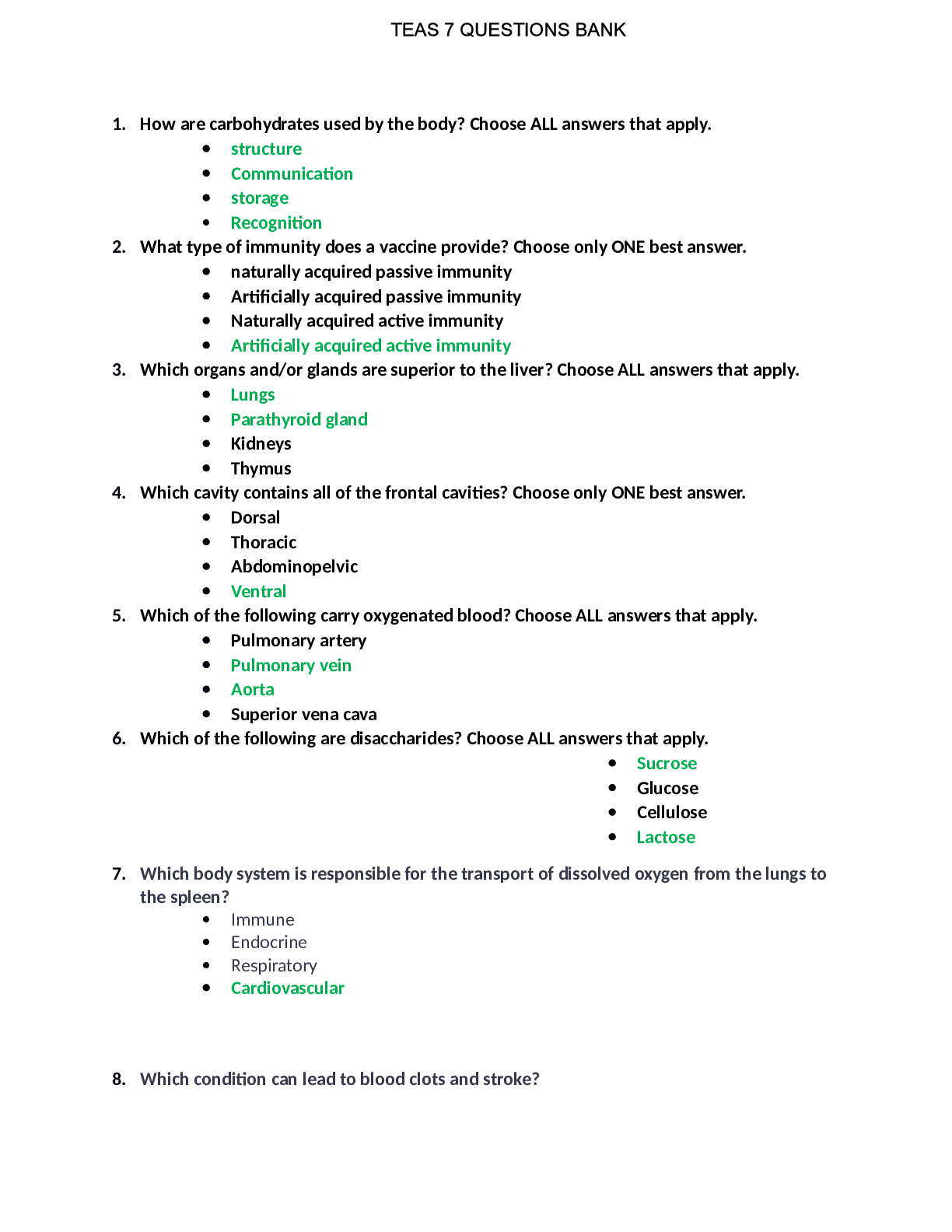
Reviews( 0 )
Document information
Connected school, study & course
About the document
Uploaded On
Jan 04, 2023
Number of pages
62
Written in
Additional information
This document has been written for:
Uploaded
Jan 04, 2023
Downloads
0
Views
36

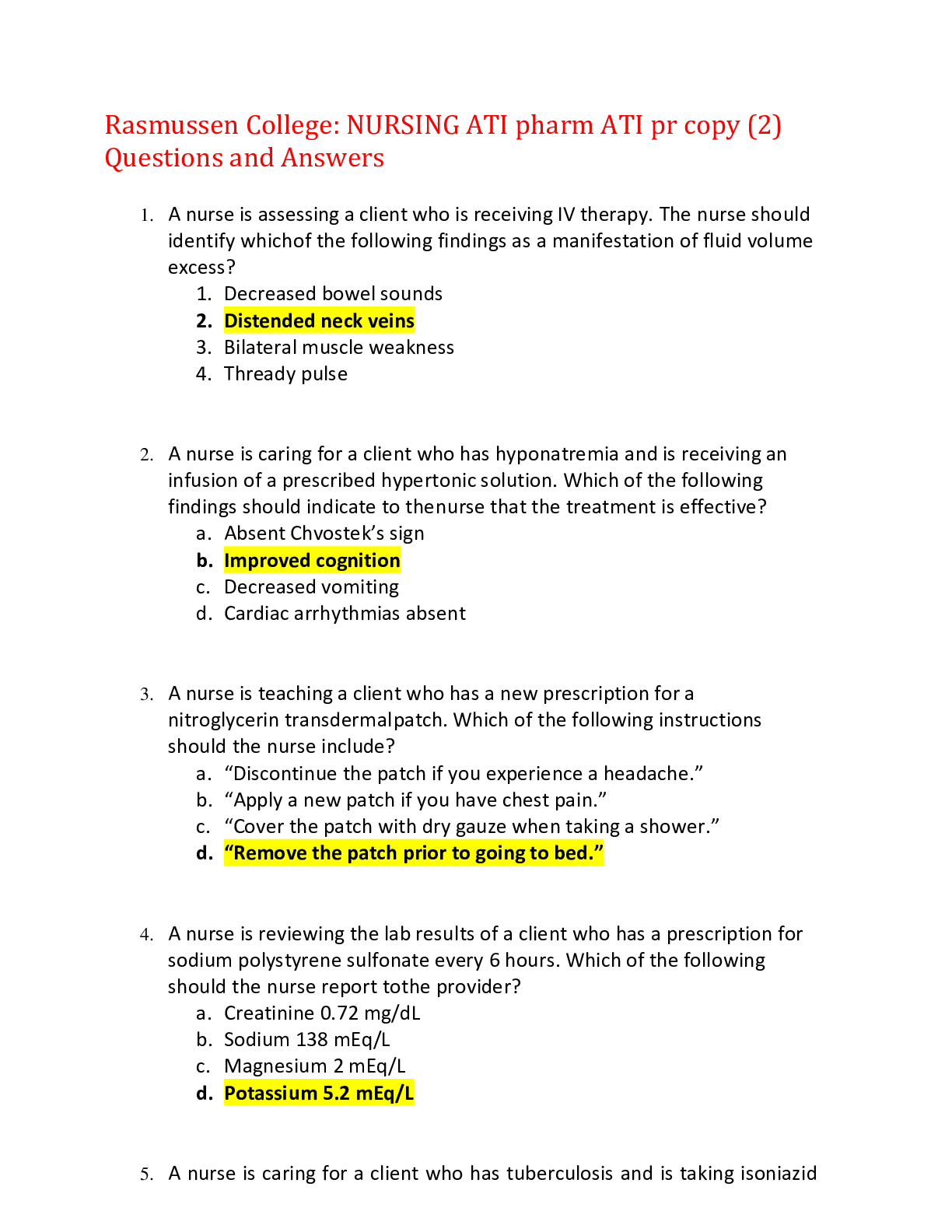

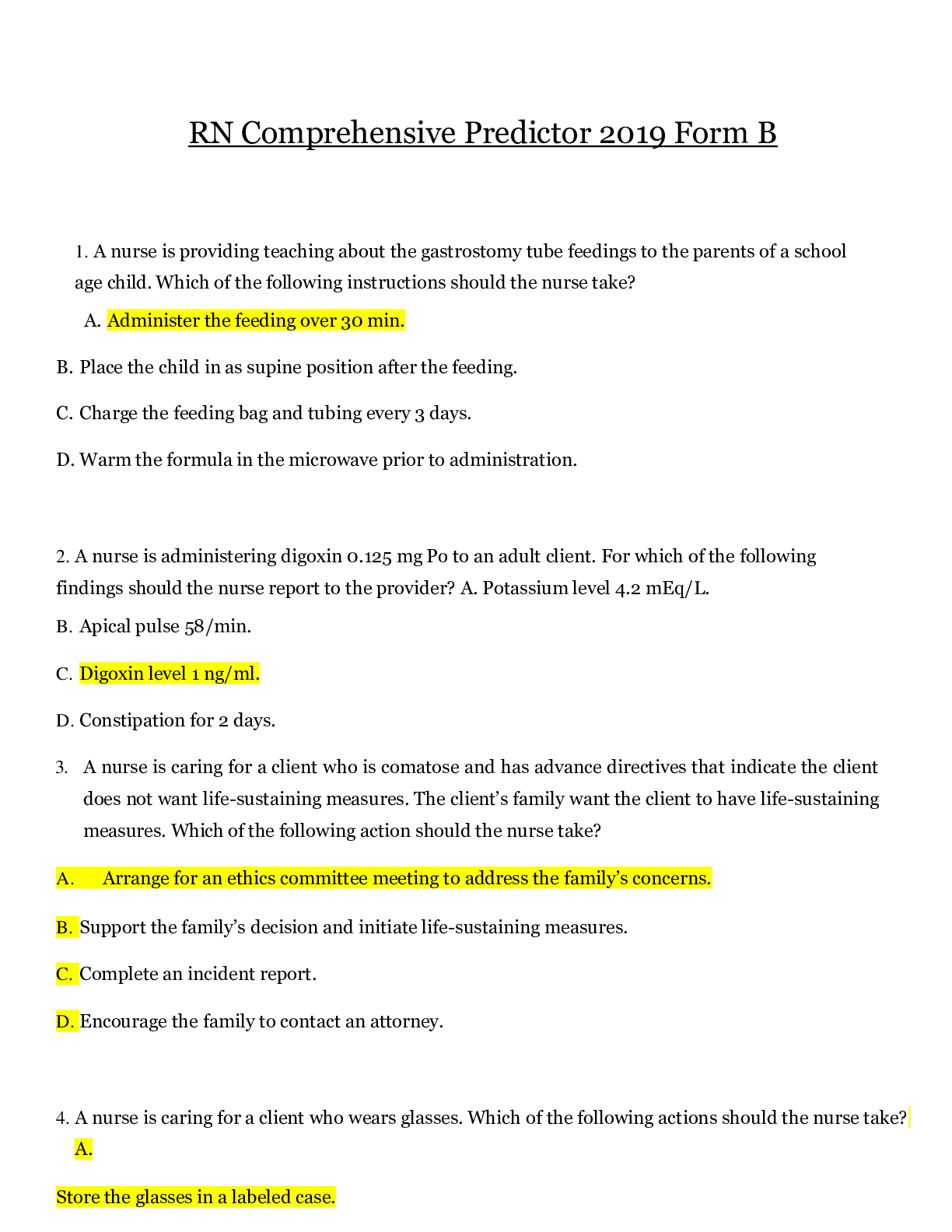
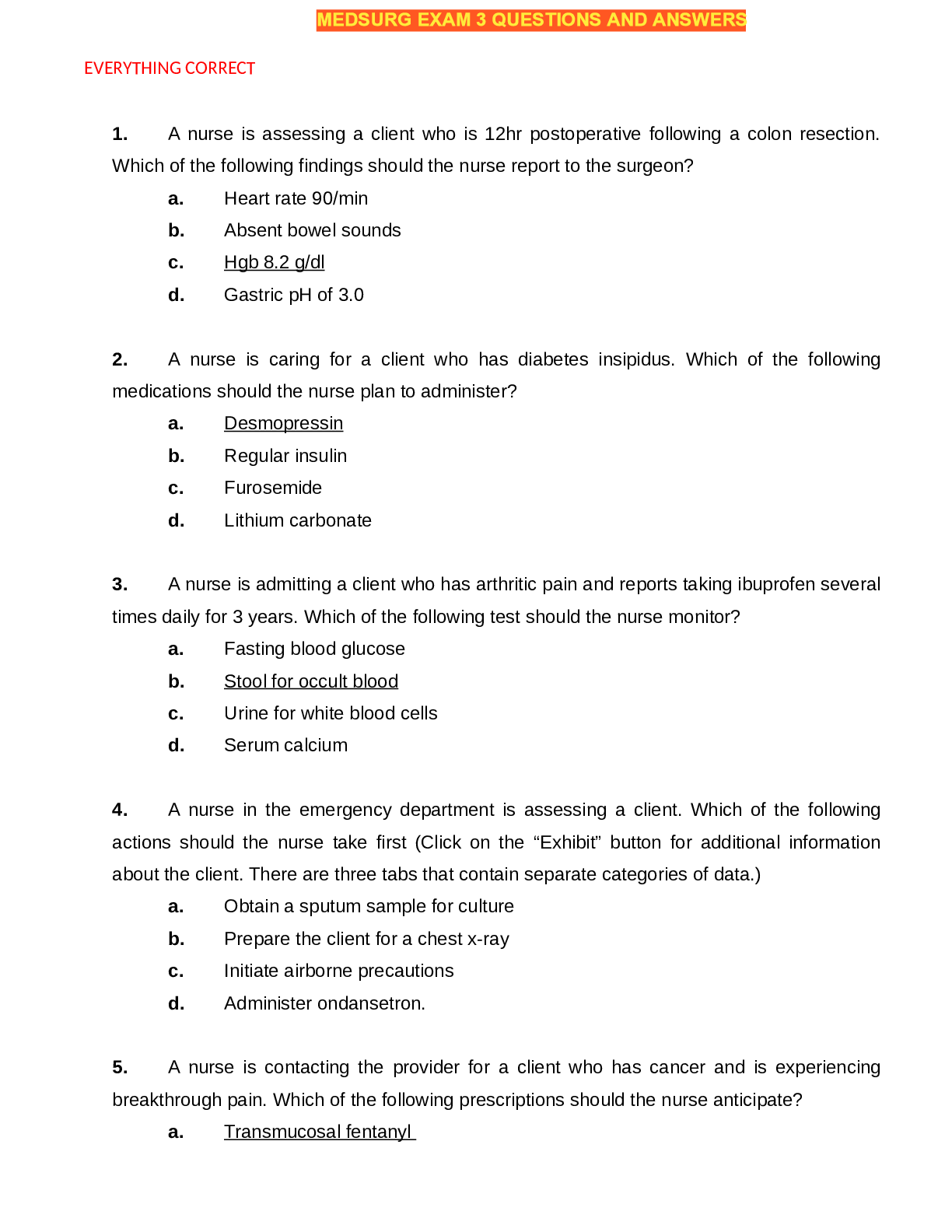
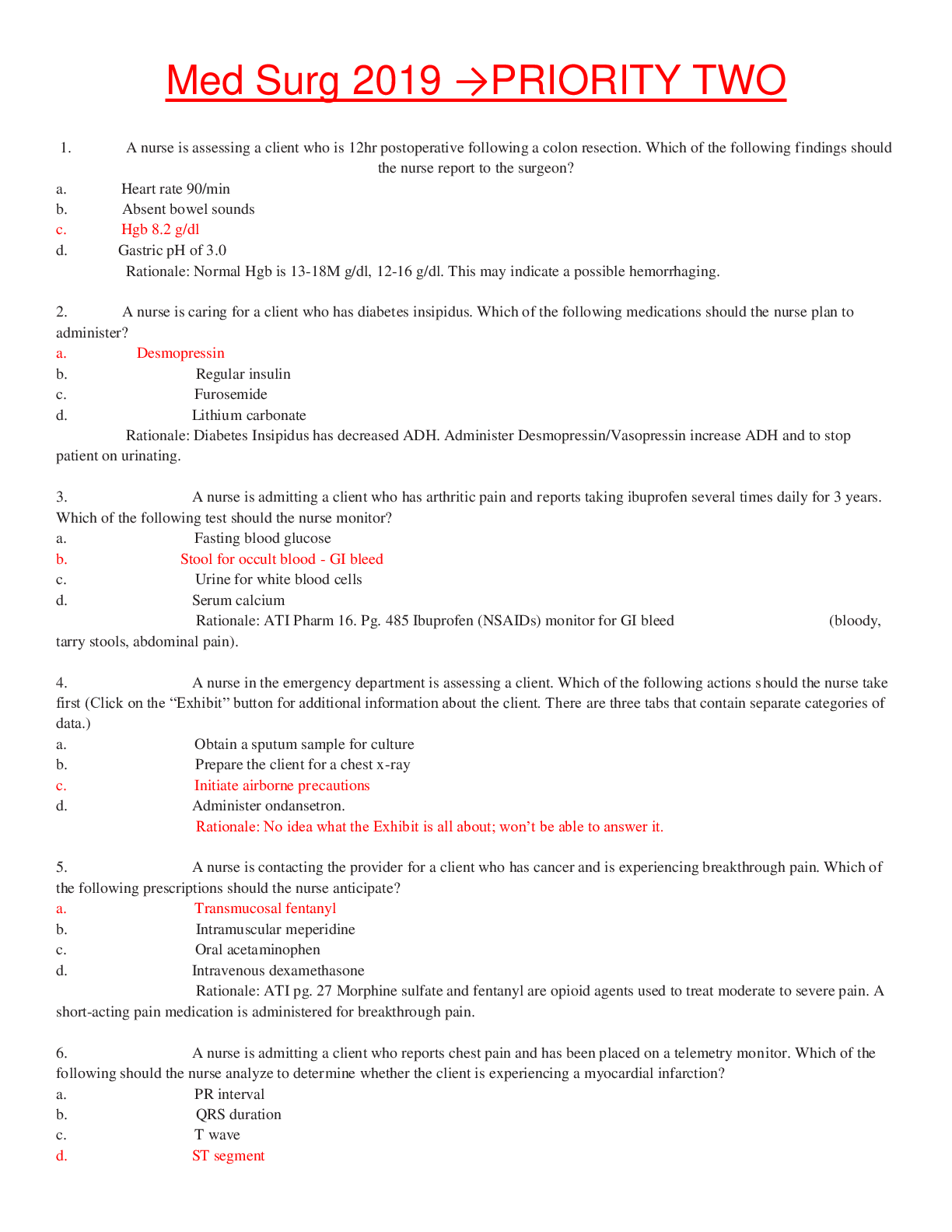
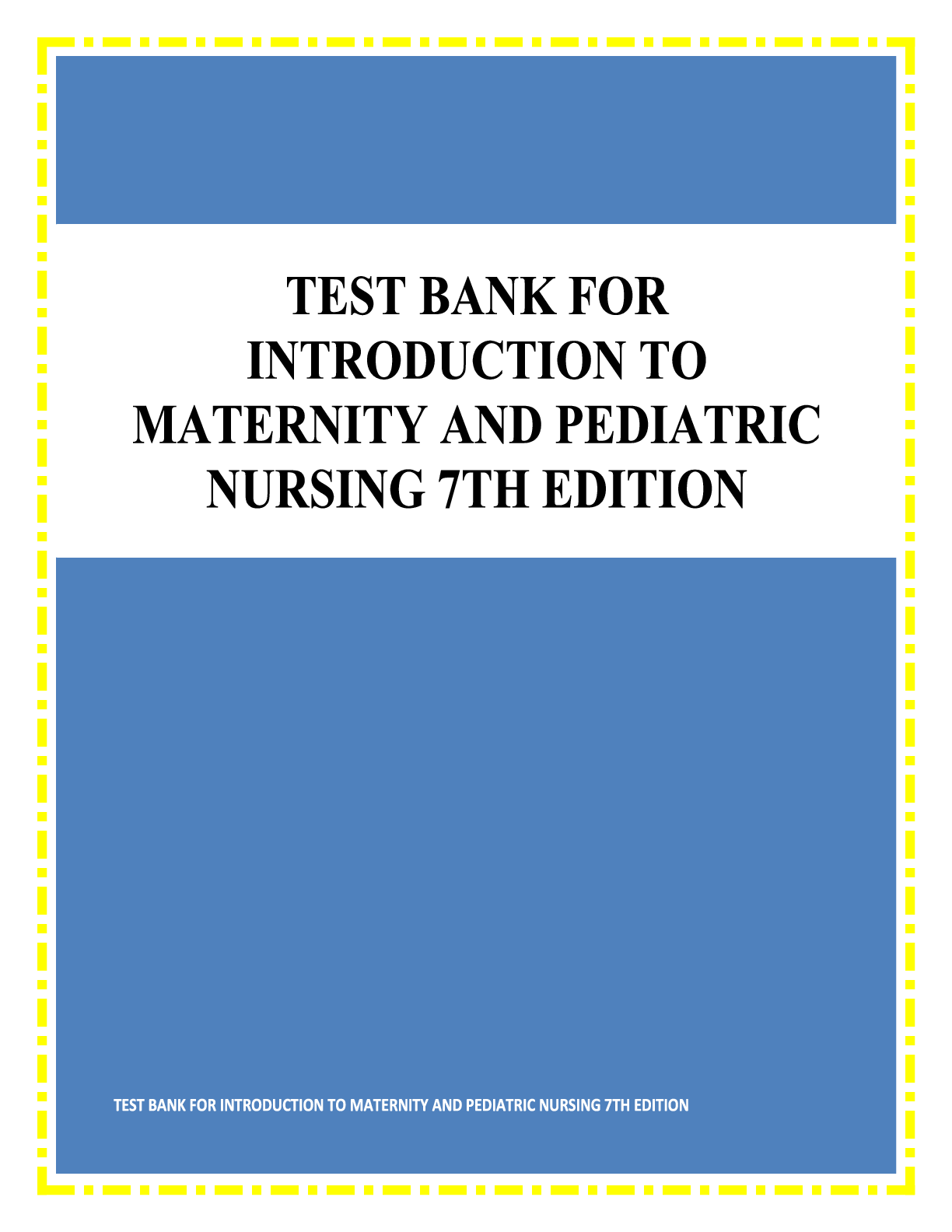
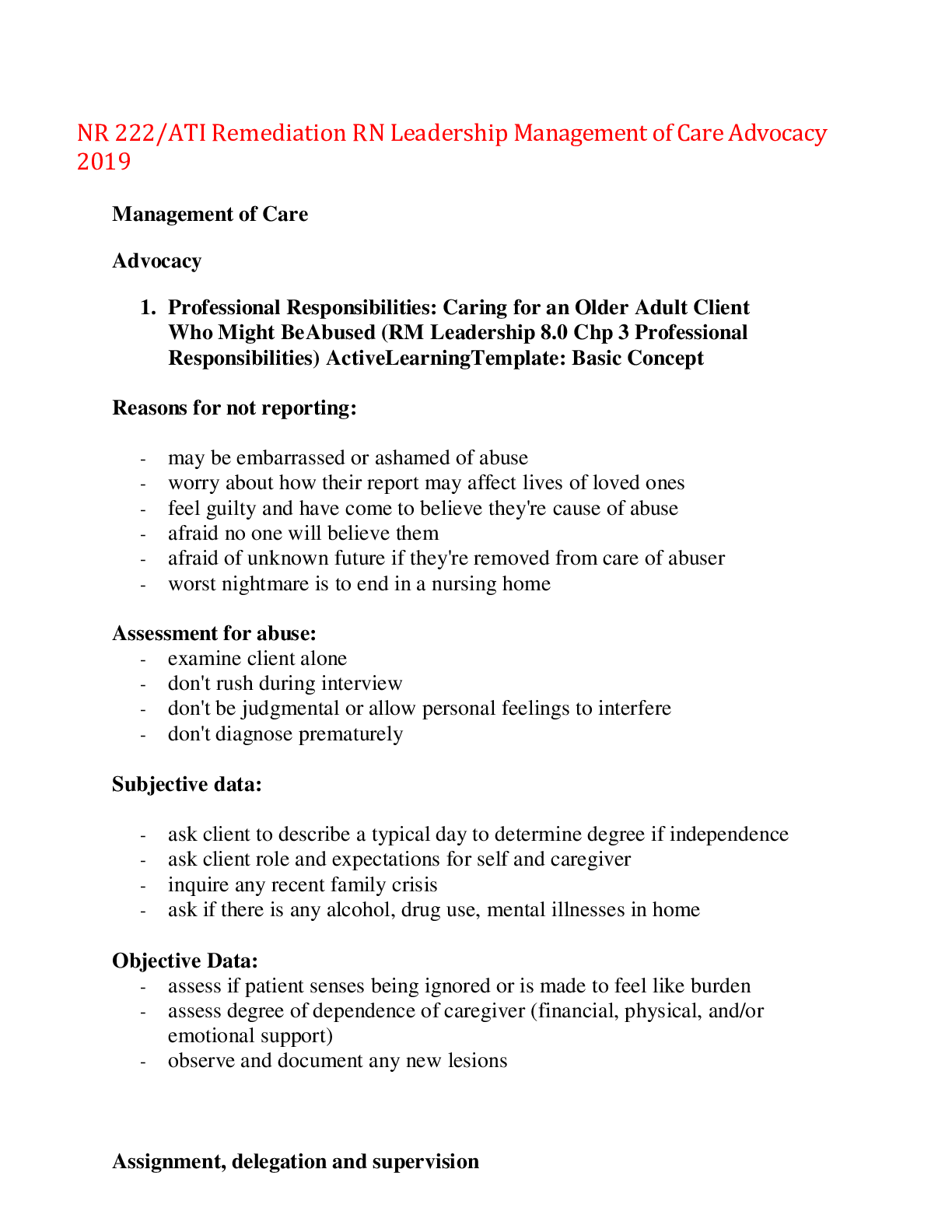
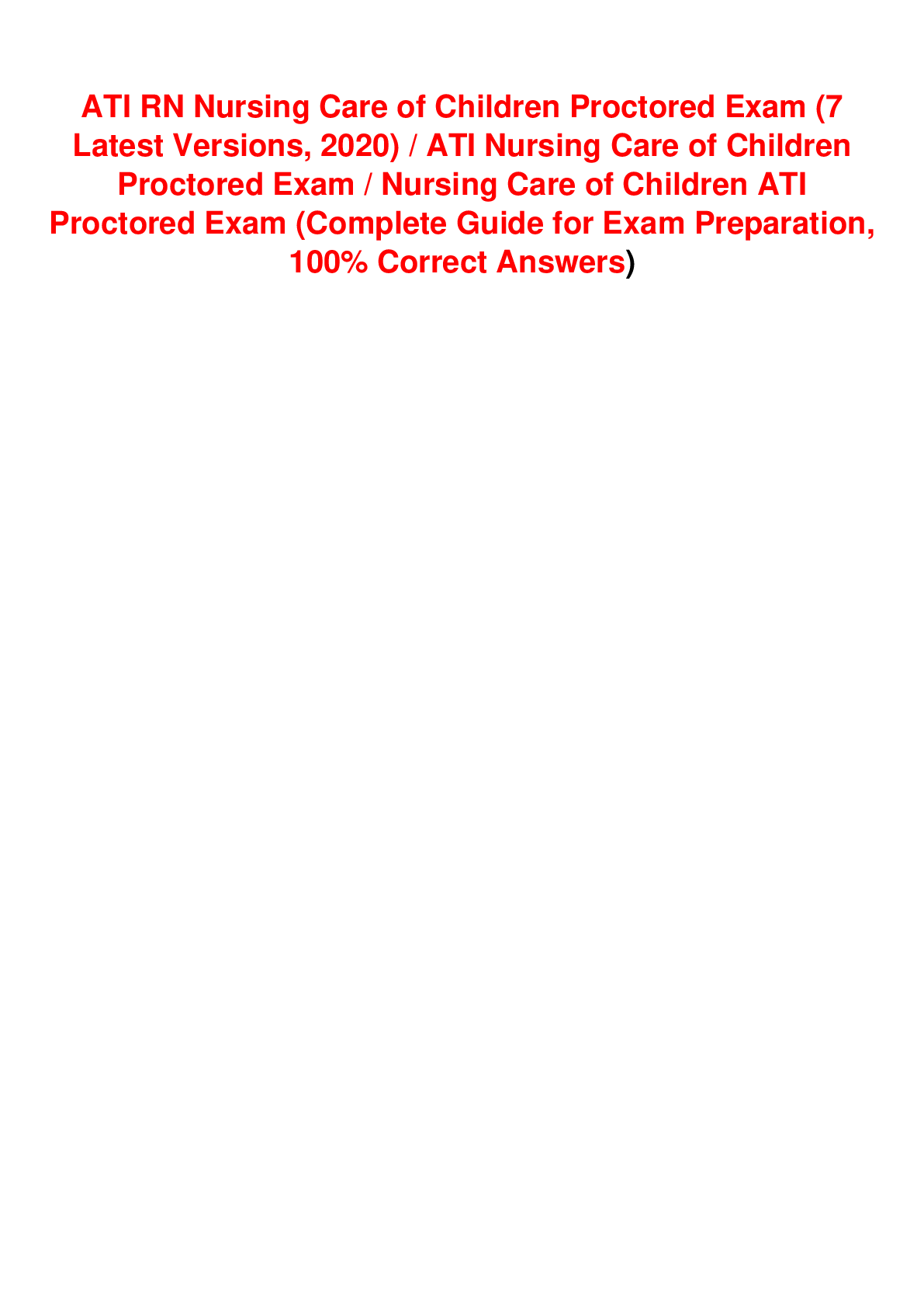
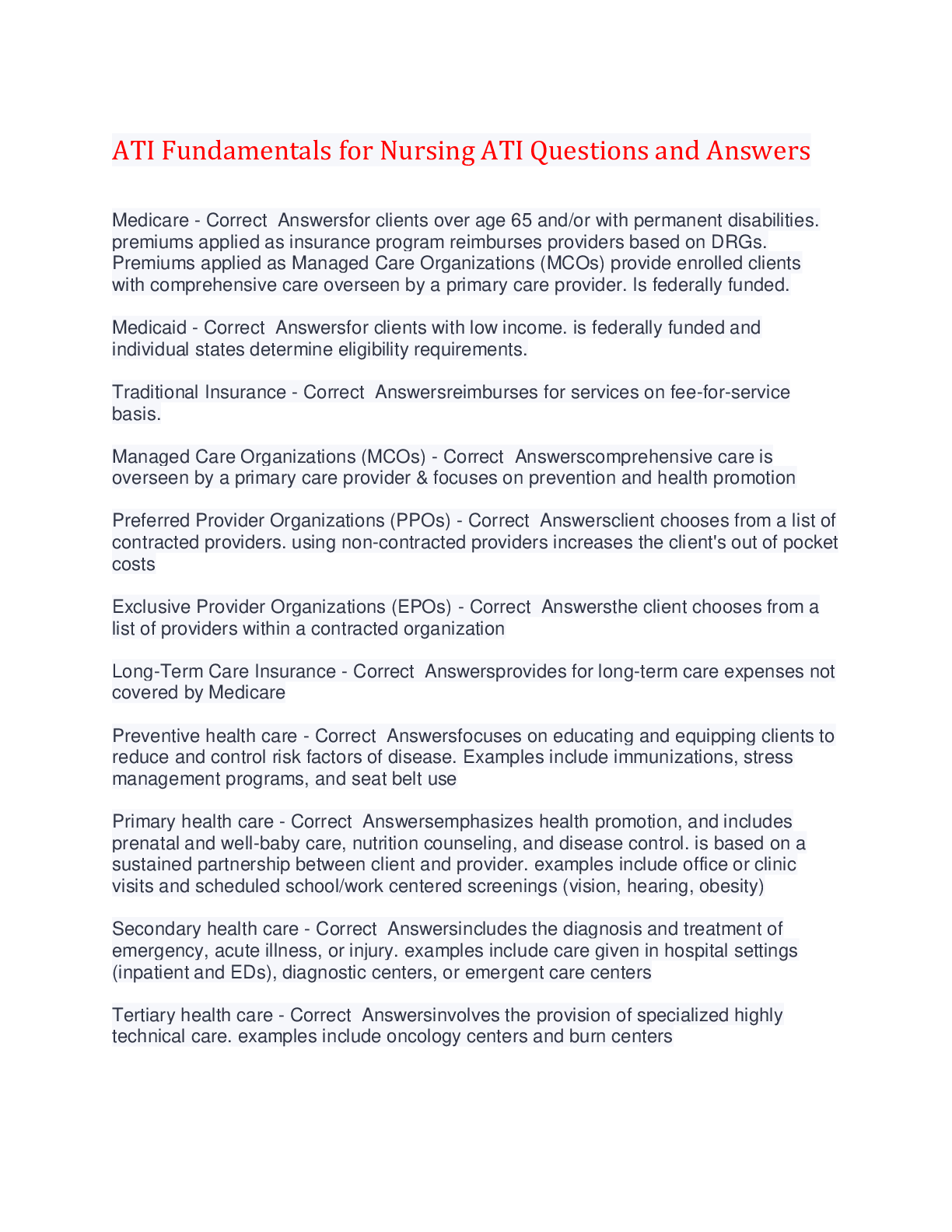
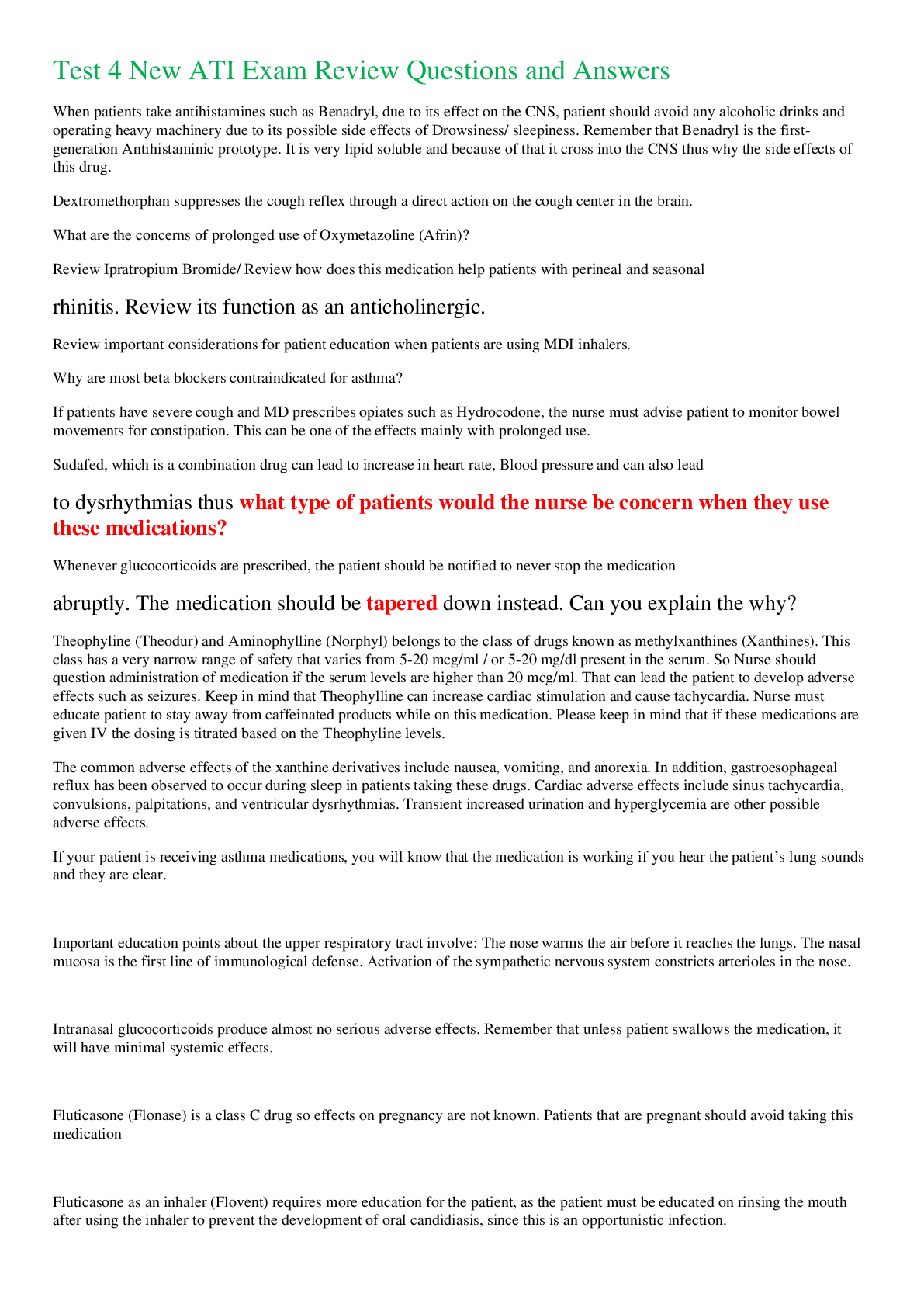

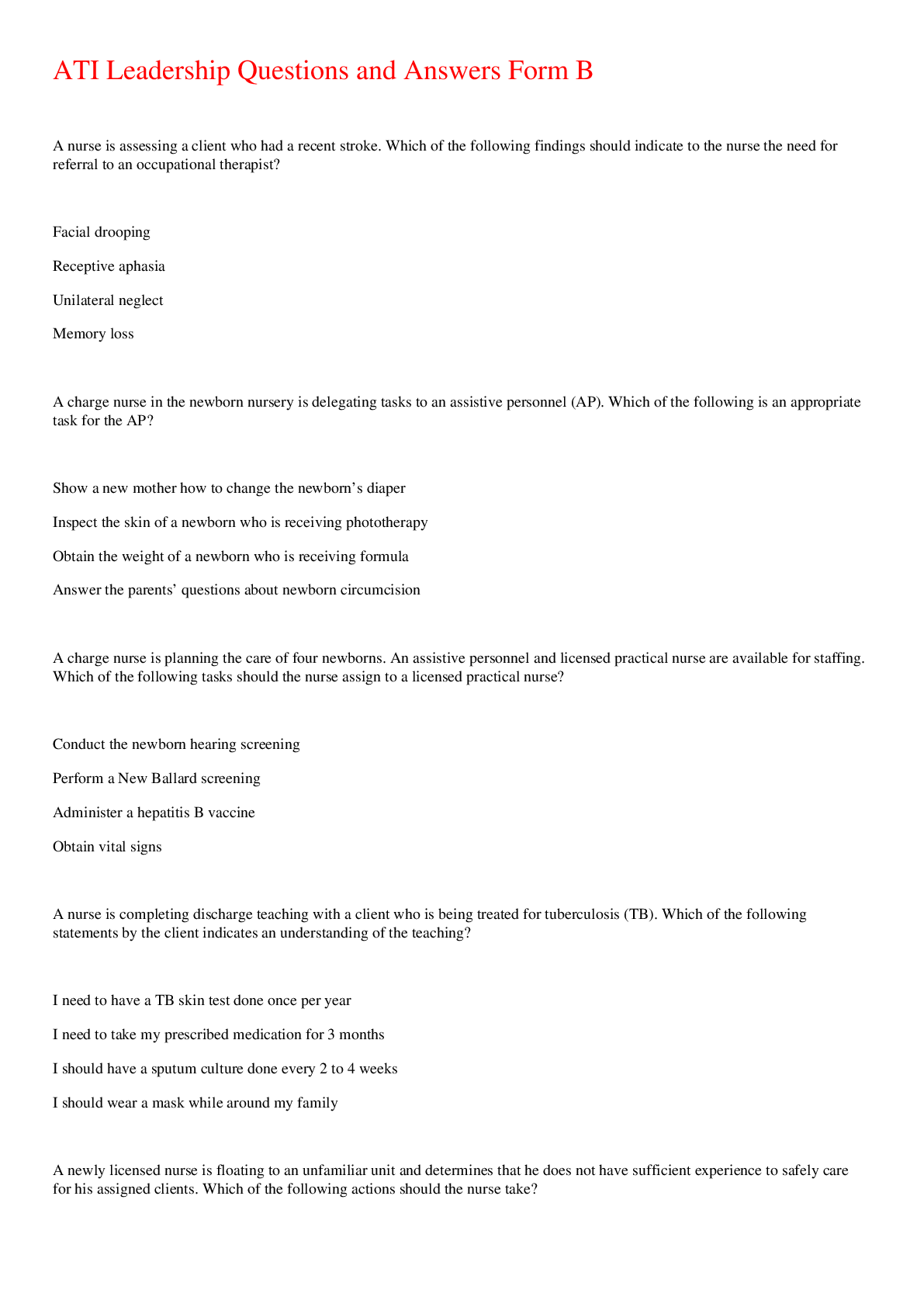
_Already Graded A.png)
